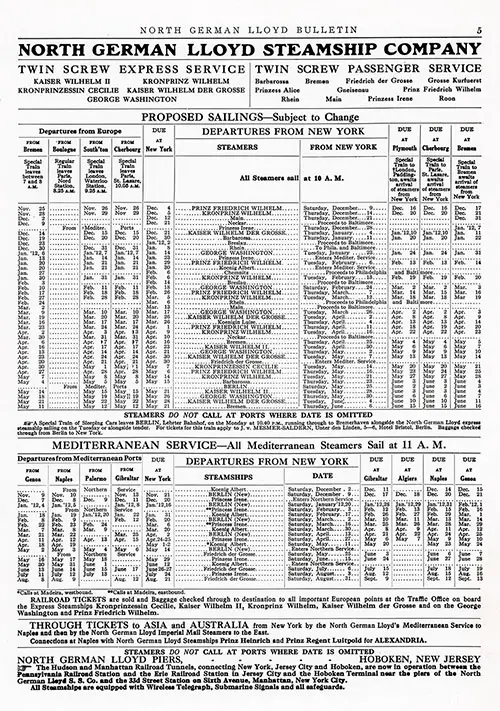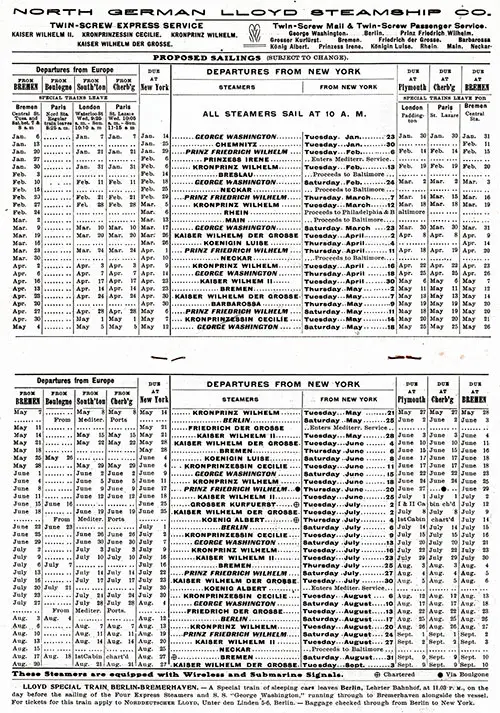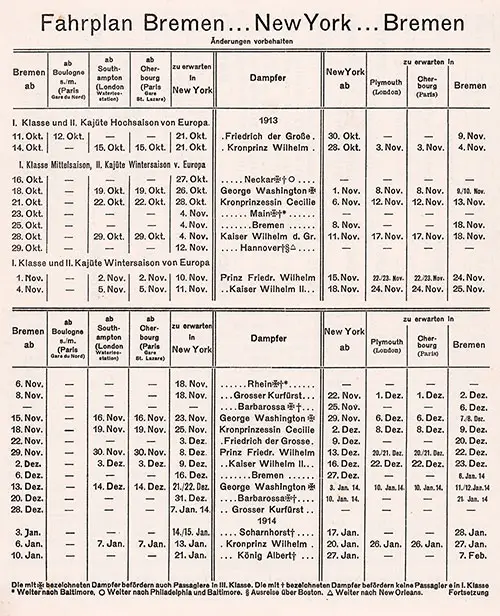SS George Washington Archival Collection
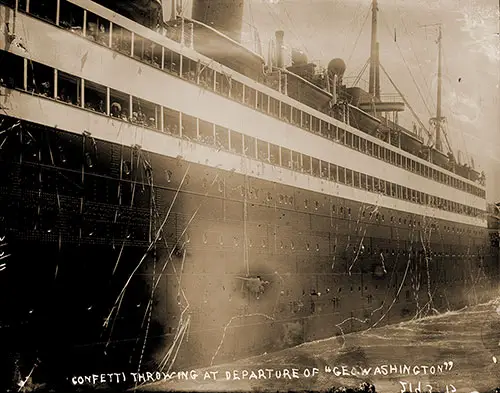
Passengers Throwing Confetti at the Departure from New York of the SS George Washington of the Norddeutscher Lloyd Bremen (North German Lloyd), 25 February 1911. The Ship Arrived in Bremen, German on 7 March 1911. Bain News Service. Library of Congress LC # 2014689159. | GGA Image ID # 1d6f34b361
Content Links
- George Washington (1908) North German Lloyd / United States Lines Ship's History (Brief)
- Passenger Lists
- Brochures
- Passage Contracts, Tickets, and Receipts
- Menus
- Sailing Schedules
- Advertisements
- Postcards
- Books Referencing the SS George Washington
- Fleet List
- Photographs
- Back Cover Images
- Excerpts from Information for Passengers
- Taxi Rates
- SS George Washington - America's Largest Passenger Liner - 1921
George Washington (1908) North German Lloyd / United States Lines
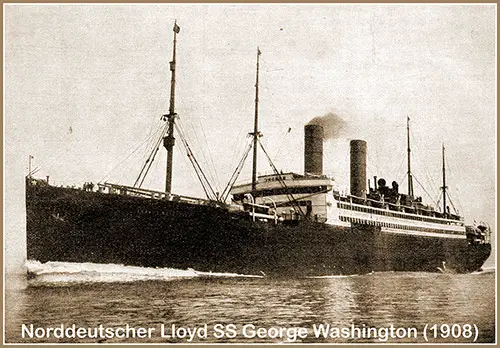
SS George Washington of the Norddeutscher Lloyd (1908). | GGA Image ID # 1d72dc6c63
Built by "Vulkan" Werke, Stettin, Germany. Tonnage: 25,570. Dimensions: 699'x 78' (722' o.l.). Propulsion: Twin-screw, 19 knots. Quadruple expansion engines. Masts and Funnels: Four masts and two funnels. Her highest masts were 193 feet above the keel. Additional Features: Length of upper promenade deck was 328 feet. Two elevators were installed. Passengers: 520 first, 377 second, 2,000 third. Maiden voyage: Bremen-Southampton-New York, June 12, 1909. Seized by the United States in 1917 and converted to troopship. After the war she was first employed by United States Mail Steamship Company for a brief time. Sold to United States Lines in 1921. Thoroughly reconditioned for their trans-Atlantic service. Laid up in the Patuxent River, Maryland, in 1931. In 1940 was removed from her moorings and outfitted as a troopship. Renamed: Catlin (1941). Her name soon reverted back to George Washington. WW2 Changes: From June 1942 to April 1943, she underwent an extensive overhaul. New oil-burning boilers were installed and original funnels replaced by a single modern one, which changed her appearance greatly. Fate: Gutted by fire while laid up at Baltimore, January 16, 1951. The hulk was broken up soon afterwards.
Return to Content Links
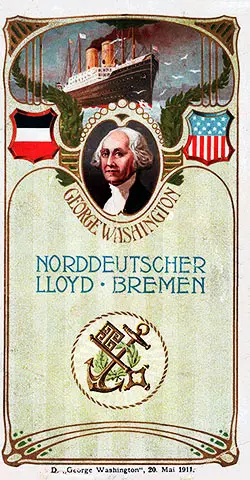
1911-05-20 SS George Washington Passenger List
- Steamship Line: North German Lloyd / Norddeutscher Lloyd
- Class of Passengers: First and Second Cabin
- Date of Departure: 20 May 1911
- Route: Bremen to New York via Southampton and Cherbourg
- Commander: Captain Ch. Polack

1912-06-01 SS George Washington Passenger List
Steamship Line: North German Lloyd / Norddeutscher Lloyd
Class of Passengers: Cabin
Date of Departure: 1 June 1912
Route: Bremen to New York via Southampton and Cherbourg
Commander: Captain B. Wilhelm

1912-09-21 SS George Washington Passenger List
Steamship Line: North German Lloyd / Norddeutscher Lloyd
Class of Passengers: Cabin
Date of Departure: 21 September 1912
Route: Bremen to New York via Southampton and Cherbourg
Commander: Captain Ch. Polack

1912-10-19 SS George Washington Passenger List
Steamship Line: North German Lloyd / Norddeutscher Lloyd
Class of Passengers: Cabin
Date of Departure: 19 October 1912
Route: Bremen to New York via Southampton and Cherbourg
Commander: Captain Ch. Polack

1912-12-14 SS George Washington Passenger List
Steamship Line: North German Lloyd / Norddeutscher Lloyd
Class of Passengers: Cabin
Date of Departure: 14 December 1912
Route: Bremen to New York via Southampton and Cherbourg
Commander: Captain Ch. Polack

1924-08-22 SS George Washington Passenger List
Steamship Line: United States Lines
Class of Passengers: Cabin
Date of Departure: 22 August 1924
Route: Bremen to New York via Southampton and Cherbourg
Commander: Captain H. A. Cunningham, U.S.N.R.F
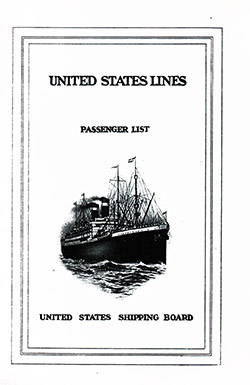
1924-09-19 SS George Washington Passenger List
Steamship Line: United States Lines
Class of Passengers: Cabin
Date of Departure: 19 September 1924
Route: Bremen to New York via Southampton and Cherbourg
Commander: Captain H. A. Cunningham

1925-09-23 SS George Washington Passenger List
Steamship Line: United States Lines
Class of Passengers: First and Second Class
Date of Departure: 23 September 1925
Route: Bremen to New York via Southampton and Cherbourg
Commander: Captain H. A. Cunningham, U.S.N.R.F
Récapitulation: 375 First Cabin, 431 Second Cabin, 675 Third Class, 639 Officers and Crew, 2,120 Total Souls on Board.

1928-05-19 SS George Washington Passenger List
Steamship Line: United States Lines
Class of Passengers: Tourist Third Cabin
Date of Departure: 19 May 1928
Route: New York to Bremen via Plymouth and Cherbourg
Commander: Captain A. B. Randall, USNR.

1928-06-06 SS George Washington Passenger List
Steamship Line: United States Lines
Class of Passengers: Tourist Third Cabin
Date of Departure:
Route: Bremen to New York via Southampton and Cherbourg
Commander: Captain A. B. Randall, USNR

1930-08-05 SS George Washington Passenger List
Steamship Line: United States Lines
Class of Passengers: Tourist Third Cabin
Date of Departure: 5 August 1930
Route: Hamburg to New York via Southampton, Cherbourg, and Cobh (Queenstown)
Commander: Captain A. B. Randall

1930-09-25 SS George Washington Passenger List
Steamship Line: United States Lines
Class of Passengers: Cabin Class
Date of Departure: 25 September 1930
Route: Hamburg to New York via Southampton and Cherbourg
Commander: Captain A. B. Randall, U.S.N.R.
Récapitulation: 404 Cabin, 275 Tourist, 145 Third Class, 1 Sea Post Official, 603 Officers and Crew, 1,428 Total Souls on Board.

1931-09-08 SS George Washington Passenger List
Steamship Line: United States Lines
Class of Passengers: Cabin Class
Date of Departure: 8 September 1931
Route: Hamburg to New York via Southampton and Cherbourg
Commander: Captain Geo. Fried, U.S.N.R.
Récapitulation: 442 Cabin, 256 Tourist, 120 Third Class, 2 Sea Post Officials, 573 Officers and Crew, 1,393 Total Souls on Board.
Return to Content Links

1922 - Passenger Ships of the United States Lines
One of the first and most comprehensive brochures on the early beginnings of the United States Lines. Many photographs documents the cabin class (First Class/Second Class) amenities on the many ships of the USL.
Undated, but likely published in 1922 before the Leviathan came into service in 1923. Featured Ships: George Washington, America, President Roosevelt, President Harding, President Monroe, President Adams, President Van Buren, President Polk, President Garfield, President Fillmore, and President Arthur.

1923 - USL Third Class Passage to Europe
The ships included in this 1923 brochure from the United States Lines include the great Leviathan, the largest liner in the world; the popular George Washington; America, largest "cabin" ship in the world; the famous "President" ships, President Harding and President Roosevelt, and the newly reconditioned Republic.

1924 - USL - New York - Plymouth - Cherbourg - Southampton - Bremen
32-Page brochure from the United States Lines provides many interior views of their fleet of transatlantic steamships published in 1924. This brochure does not include their flagship -- the SS Leviathan as they prepared a separate booklet for that ship. Featured Ships: George Washington, President Harding, President Roosevelt, and Republic.
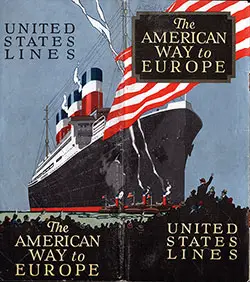
1924 - United States Lines - The American Way to Europe
Comprehensive brochure from the United States Lines developed to provide information and photographs that describe the ships and amenities geared to Americans traveling to Europe. Also contains brief information on sites to see in European countries along with passport information.
Featured Ships: America, George Washington, Leviathan, President Harding, President Roosevelt, and Republic. Includes 5 exterior illustrations and 17 interior/deck photographs. A few of the photos show famous people who have traveled on the ship including Queen Marie of Romania, Will Rogers, and others.
Return to Content Links
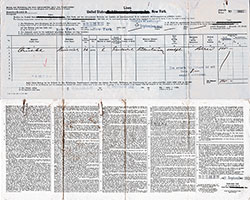
SS George Washington Passage Contract - 17 September 1921
Contract for Third Class/Steerage Passage on the SS George Washington by a German Immigrant on 17 September 1921, Sailing from Bremen to New York. This Immigrant Carried a Certificate of Innocence with Him for the Immigration Authorities.
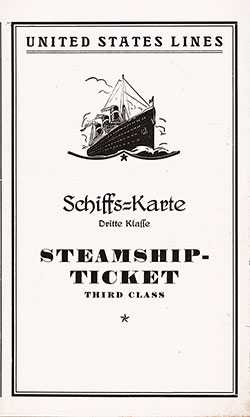
SS George Washington Passage Contract - 3 October 1928
Third Class Passenger Ticket for a German National for a Transatlantic Voyage from Bremen, Germany to New York on 3 October 1928. The Contract Was Written in Both German and English.
Return to Content Links
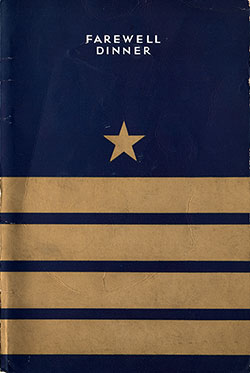
1931-07-07 SS George Washington Farewell Dinner Menu
Stately Farewell Dinner Bill of Fare and Musical Program, complete with a photograph of the dinner guests for this 7 July 1931 meal on board the SS George Washington of the United States Lines. Includes Photo of Dinner Guest at Farewell Gala.
Return to Content Links
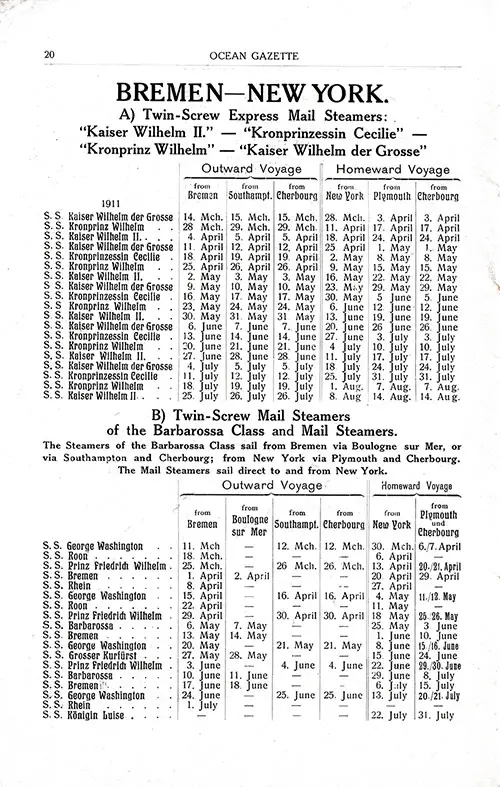
Sailing Schedules, (A) Twin-Screw Mail Steamers, Bremen-Southampton-Cherbourg-New York and New York-Plymouth-Cherbourg-Bremen, from 14 March 1911 to 14 August 1911, (B) Barbarossa Class Twin-Screw Mail Steamers and Mail Steamers, Bremen-Boulogne-sur-Mer-Southampton-Cherbourg-New York and New York-Plymouth-Cherbourg-Bremen, from 11 March 1911 to 31 July 1911. Ships Included Barbarossa, Bremen, George Washington, Grosser Kurfürst, Kaiser Wilhelm der Grosse, Kaiser Wilhelm II, Königin Luise, Kronprinz Wilhelm, Kronprinzessin Cecilie, Prinz Friedrich Wilhelm, Rhein, and Roon. Ocean Gazette, Kaiser Wilhelm II Edition, 9 April 1911. | GGA Image ID # 1ebbaab891
Proposed Sailings, Bremen-New York and New York-Mediterranean Services, from 10 November 1911 to 13 September 1912. Ships Included the Baarbarossa, Berlin, Bremen, Breslau, Chemnitz, George Washington, Kaiser Wilhelm der Grosse, Kaiser Wilhelm II, Koenig Albert, Koenigin Luise, Kronprinz Wilhelm, Main, Neckar, Prinz Friedrich Wilhelm, Prinzess Irene, and Rhein. North German Lloyd Bulletin, December 1911. | GGA Image ID # 1e304c62cd. Click to View Larger Image.
Sailing Schedule, Bremen-New York, from 6 January 1912 to 10 September 1912. Ships Included the Barbarossa, Berlin, Bremen, Breslau, Chemnitz, Friedrich der Grosse, George Washington, Grosser Kurfürst, Kaiser Wilhelm der Grosse, Kaiser Wilhelm II, König Albert, Königin Luise, Kronprinz Wilhelm, Kronprinzessin Cicilie, Main, Neckar, Prinz Friedrich Wilhelm, Prinzess Irene, and Rhein. SS Berlin First and Second Cabin Passenger List, 20 January 1912. | GGA Image ID # 20d7a7de48. Click to View Larger Image.
Sailing Schedule, Bremen-New York, from 6 January 1912 to 10 September 1912. Ships Included the Barbarossa, Berlin, Bremen, Breslau, Chemnitz, Friedrich der Grosse, George Washington, Grosser Kurfürst, Kaiser Wilhelm der Grosse, Kaiser Wilhelm II, König Albert, Königin Luise, Kronprinz Wilhelm, Kronprinzessin Cicilie, Main, Neckar, Prinz Friedrich Wilhelm, Prinzess Irene, and Rhein. SS Berlin First and Second Cabin Passenger List, 20 January 1912. | GGA Image ID # 20d7a7de48. Click to View Larger Image.
Sailing Schedule, Bremen-Boulogne-Southampton-New York and New York-Plymouth, Cherbourg-Bremen, from 11 October 1913 to 7 February 1914. Ships Included the Barbarossa, Bremen, Friedrich der Grosse, George Washington, Grosser Kurfürst, Hannover, Kaiser Wilhelm der Grosse, Kaiser Wilhelm II, König Albert, Kronprinz Wilhelm, Kronprinzessin Cecilie, Main, Neckar, Prinz Friedrick Wilhelm, Rhein, and Scharnhorst. SS Grosser Kurfürst Passenger List, 8 November 1913. | GGA Image ID # 1f66b98b01. Click to View Larger Image.
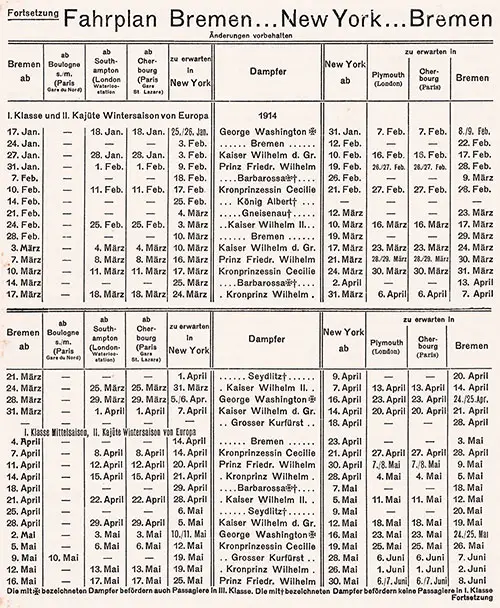
Sailing Schedule, Bremen-Boulogne-Southampton-New York and New York-Plymouth, Cherbourg-Bremen, from 18 January 1914 to 8 June 1914. Ships Included the Barbarossa, Bremen, George Washington, Gneisenau, Grosser Kurfürst, Kaiser Wilhelm der Grosse, Kaiser Wilhelm II, Kronprinz Wilhelm, Kronprinzessin Cecilie, König Albert, Prinz Friedrick Wilhelm, and Seydlitz. SS Grosser Kurfürst Passenger List, 8 Novmeber 1913. | GGA Image ID # 1f67b544a2
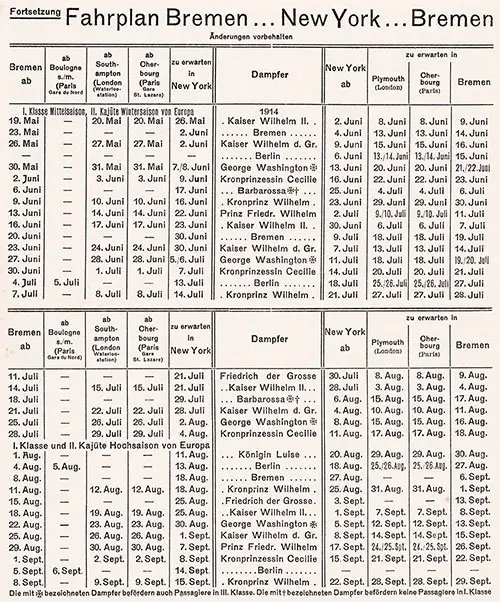
Sailing Schedule, Bremen-Boulogne-Southampton-New York and New York-Plymouth, Cherbourg-Bremen, from 19 May 1914 to 29 September 1914. Ships Included the Barbarossa, Berlin, Bremen, Friedrich der Grosse, George Washington, Kaiser Wilhelm der Grosse, Kaiser Wilhelm II, Königin Luise, Kronprinz Wilhelm, Kronprinzessin Cecilie, and Prinz Friederich Wilhelm. SS Grosser Kurfürst Passenger List, 8 Novmeber 1913. | GGA Image ID # 1f67d45296
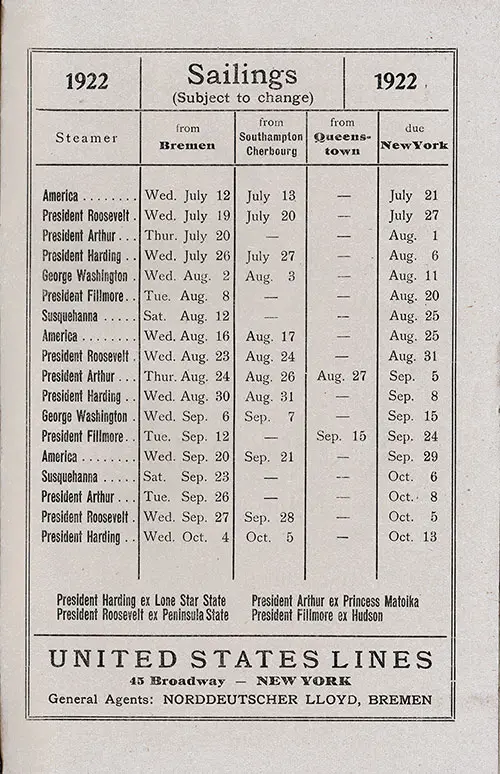
Sailing Schedule, Bremen-Southampton-Cherbourg-Queenstown (Cobh)-New York, from 12 July 1922 to 13 October 1922. Ships Included the America, George Washington, President Arthur, President Filmore, President Harding, President Roosevelt, and Susquehanna. SS America Passenger List, 12 July 1922. | GGA Image ID # 1e2d1b41c3
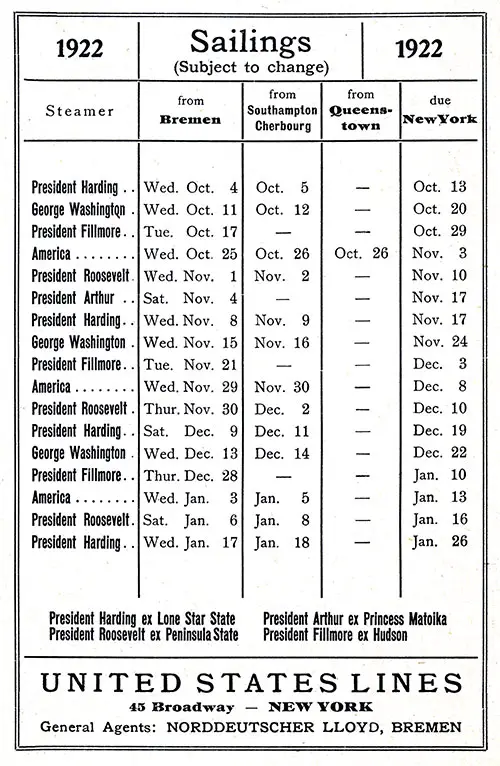
Sailing Schedule, Bremen-Southampton-Cherbourg-Queenstown-New York, from 4 October 1922 to 26 January 1923. Ships Included the America, George Washington, President Arthur, President Fillmore, President Harding, and President Roosevelt. SS President Harding First Cabin Passenger List, 4 October 1922. | GGA Image ID # 2123e33fe4
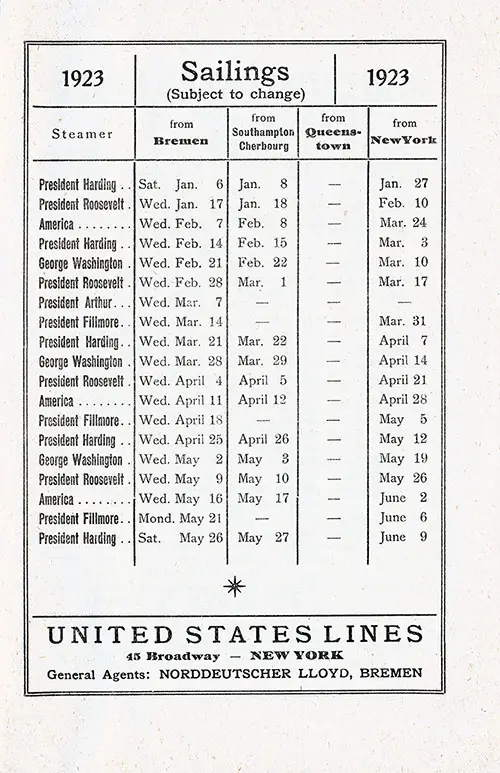
Sailing Schedule, Bremen-Southampton-Cherbourg-Queenstown (Cobh)-New York, from 6 January 1923 to 9 June 1923. Ships Included the America, George Washington, President Arthur, President Fillmore, President Harding, and President Roosevelt. SS President Harding Passenger List, 6 January 1923. | GGA Image ID # 1eed82bf51
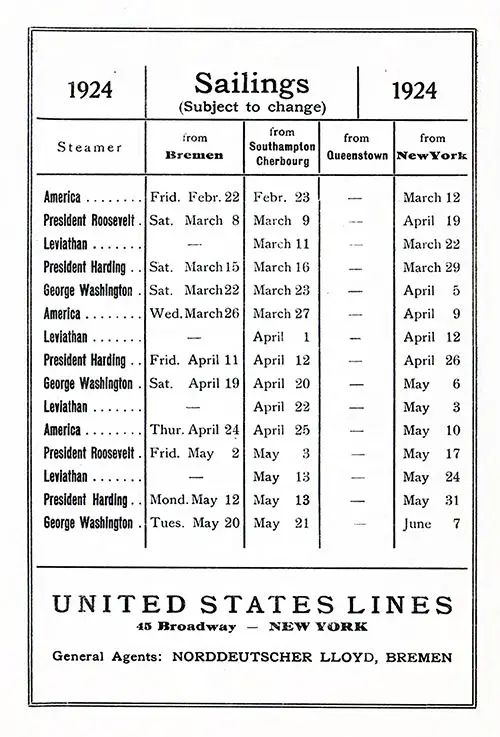
Sailing Schedule, Bremen-Southampton-Cherbourg-Queenstown (Cobh)-New York, from 22 February 1924 to 7 June 1924. Ships Included the America, George Washington, Leviathan, President Harding, and President Roosevelt. SS America Passenger List, 22 February 1924. | GGA Image ID # 1e2d267528
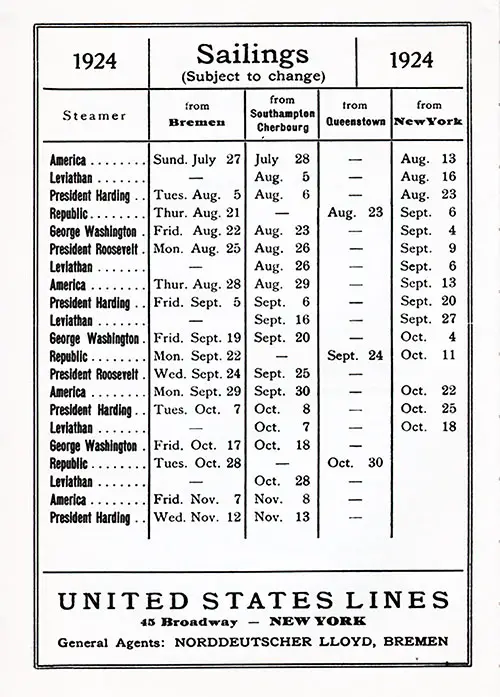
Sailing Schedule, Bremen-Southampton-Cherbourg-Queenstown (Cobh)-New York, from 27 July 1924 to 13 November 1924. Ships Included the America, George Washington, Leviathan, President Harding, President Roosevelt, and Republic. SS America Passenger List 27 July 1924. | GGA Image ID # 1e2da1c89a
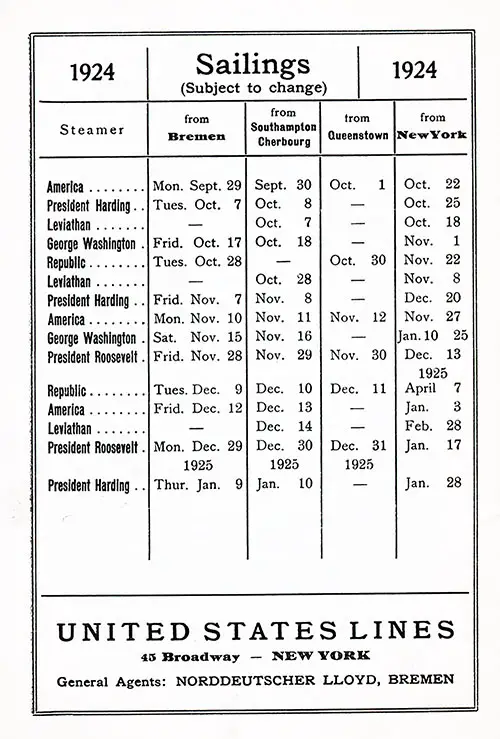
Sailing Schedule, Bremen-Southampton-Cherbourg-Queenstown (Cobh)-New York, from 29 September 1924 to 28 January 1925. Ships Included the America, George Washington, Leviathan, President Harding, and President Roosevelt. SS America Passenger List, 29 September 1924. | GGA Image ID # 1e2e31a1b9

Sailing Schedule, Bremen-Southampton-Cherbourg-Queenstown (Cobh)-New York, from 21 April 1926 to 29 September 1926. Ships Included the America, George Washington, Leviathan, President Harding, President Roosevelt, and Republic. SS President Harding Passenger List, 28 July 1926. | GGA Image ID # 1eee5e7587
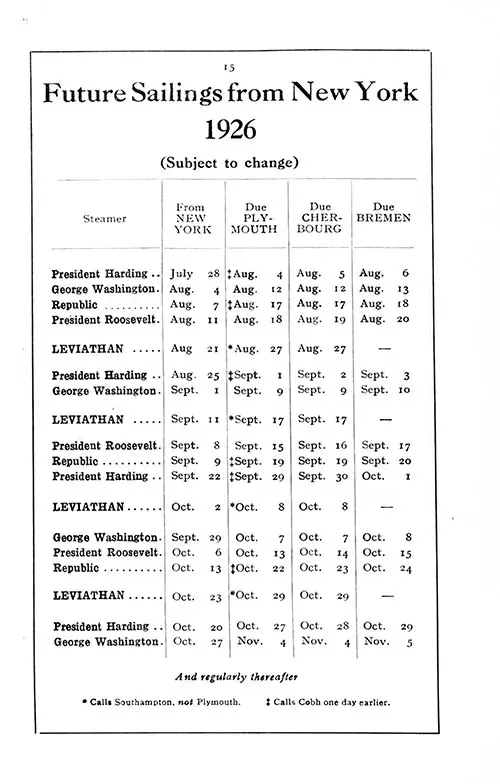
Eastbound Sailings, New York-Plymouth-Cherbourg-Bremen, from 28 July 1926 to 5 November 1926. Ships Included the George Washington, Leviathan, President Harding, President Roosevelt, and Republic. SS Leviathan Passenger List, 10 August 1926. | GGA Image ID # 1e1ca0177e
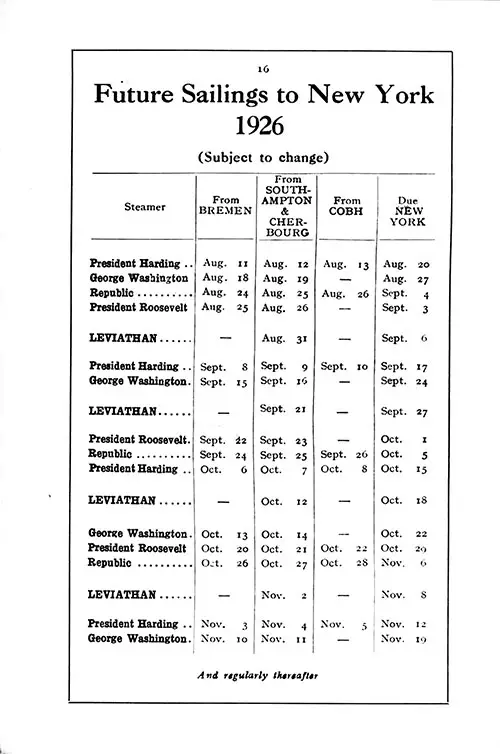
Westbound Sailings, Bremen-Southampton-Cherbourg-Cobh-New York, from 11 August 1926 to 19 November 1926. Ships Included the George Washington, Leviathan, President Harding, President Roosevelt, and Republic. SS Leviathan Passenger List, 10 August 1926. | GGA Image ID # 1e1d0d3a92
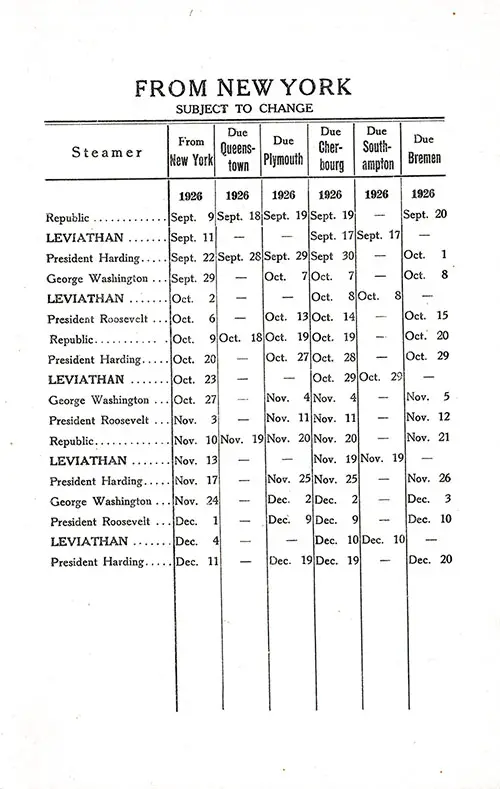
Sailing Schedule, USL Steamers from New York, from 9 September 1926 to 20 December 1926. Ships Included the George Washington, Leviathan, President Harding, President Roosevelt, and Republic. SS Republic Passenger List, 24 September 1926. | GGA Image ID # 1e59cf074f

Sailing Schedule, USL Steamers to New York, from 24 September 1926 to 5 January 1927. Ships Included the George Washington, Leviathan, President Harding, President Roosevelt, and Republic. SS Republic Passenger List, 24 September 1926. | GGA Image ID # 1e5a2cd0d2
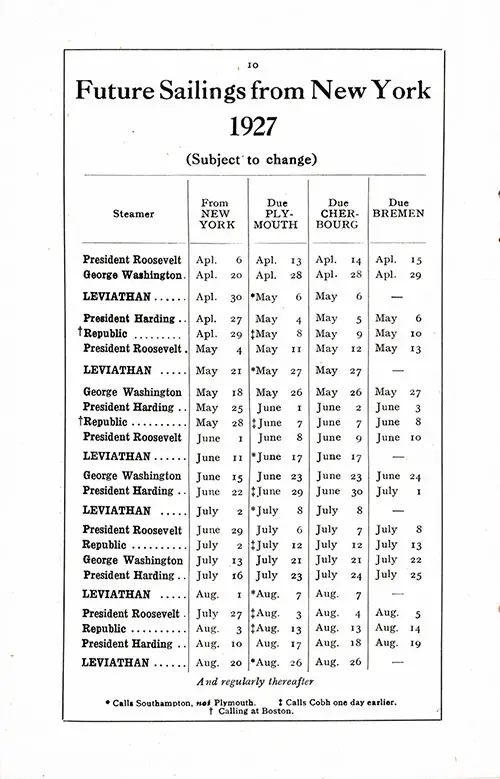
Eastbound Sailing Schedule, New York-Plymouth-Cherbourg-Bremen, from 6 April 1927 to 26 August 1926. Ships Included the George Washington, Leviathan, President Harding, President Roosevelt, and Republic. SS Leviathan Passenger List, 19 April 1927. | GGA Image ID # 1e1daba3bf

Westbound Sailing Schedule, Bremen-Southampton-Cherbourg-Cobh-New York, from 20 April 1927 to 5 September 1927. Ships Included the George Washington, Leviathan, President Harding, President Roosevelt, and Republic. SS Leviathan Passenger List, 19 April 1927. | GGA Image ID # 1e1e272d88
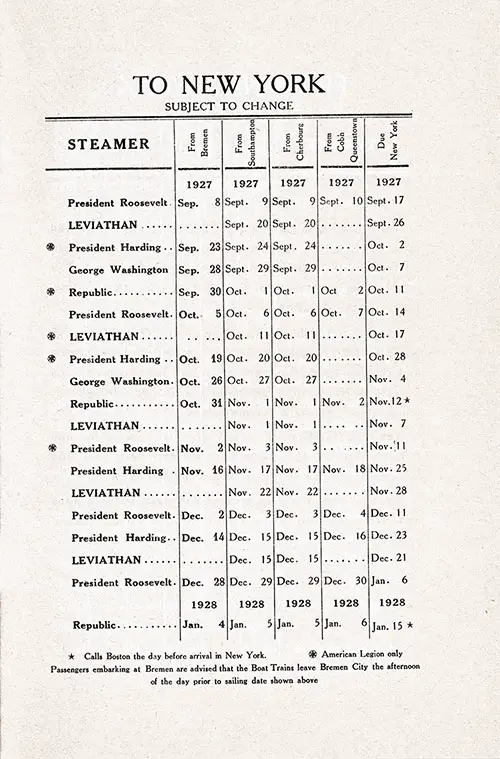
Westbound Sailing Schedule, Bremen-Southampton-Cherbourg-Cobh-New York, from 8 September 1927 to 15 January 1928. Ships Included the George Washington, Leviathan, President Harding, President Roosevelt, and Republic. SS Leviathan Passenger List, 11 October 1927. | GGA Image ID # 1e1f3b4d45
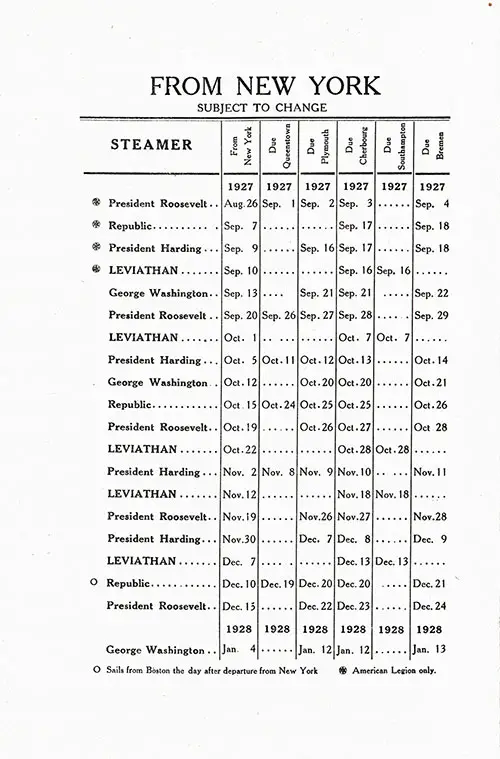
Eastbound Sailing Schedule, New York-Cobh-Plymouth-Cherbourg-Bremen, from 26 August 1927 to 13 January 1928. Ships Included the George Washington, Leviathan, President Harding, President Roosevelt, and Republic. SS Leviathan Passenger List, 11 October 1927. | GGA Image ID # 1e1ef6a539

Sailing Schedule, New York-Plymouth-Cherbourg-Bremen, from 29 February 1928 to 22 June 1928. Ships Included the America, George Washington, Leviathan, President Harding, President Roosevelt, and Repubic. SS Leviathan Passenger List, 13 March 1928. | GGA Image ID # 1e9ee0cbea
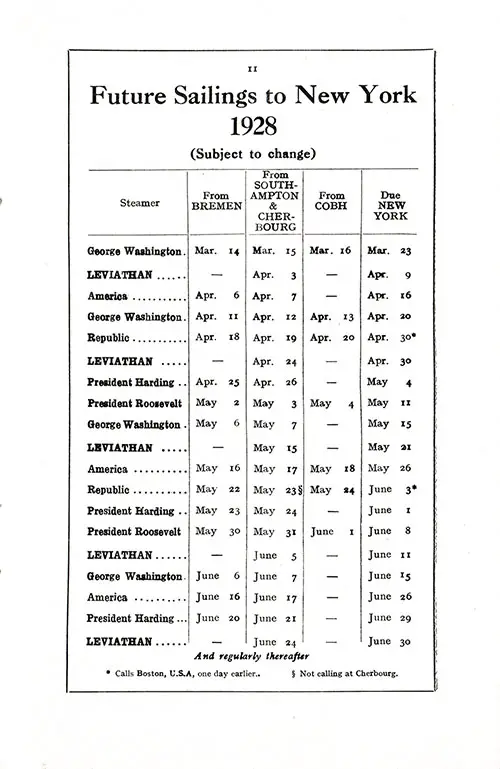
Sailing Schedule, Bremen-Southampton-Cherbourg-Cobh-New York, from 14 March 1928 to 30 June 1938. Ships Included the America, George Washington, Leviathan, President Harding, President Roosevelt, and Republic. SS Leviathan Passenger List, 13 March 1928. | GGA Image ID # 1e9f06df21
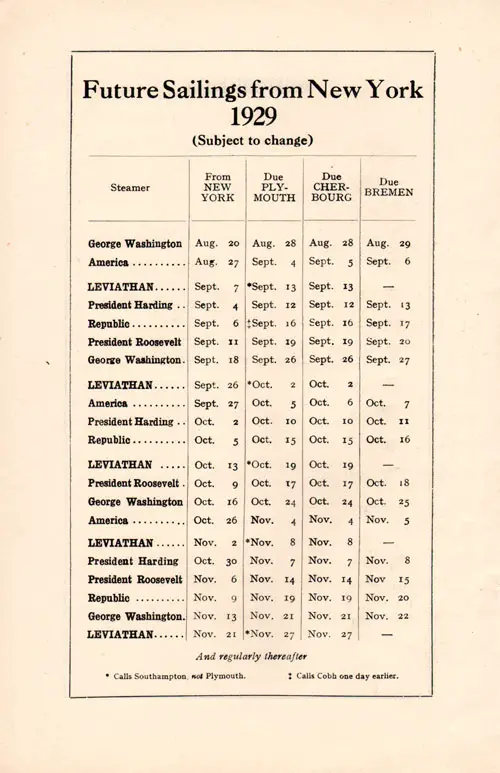
Eastbound Sailing Schedule, New York-Plymouth-Cherbourg-Bremen, from 20 August 1929 to 27 November 1929. Ships Included the America, George Washington, Leviathan, President Harding, President Roosevelt, and Republic. SS Leviathan Passenger List, 27 August 1929. | GGA Image ID # 1e1fbe0cd2
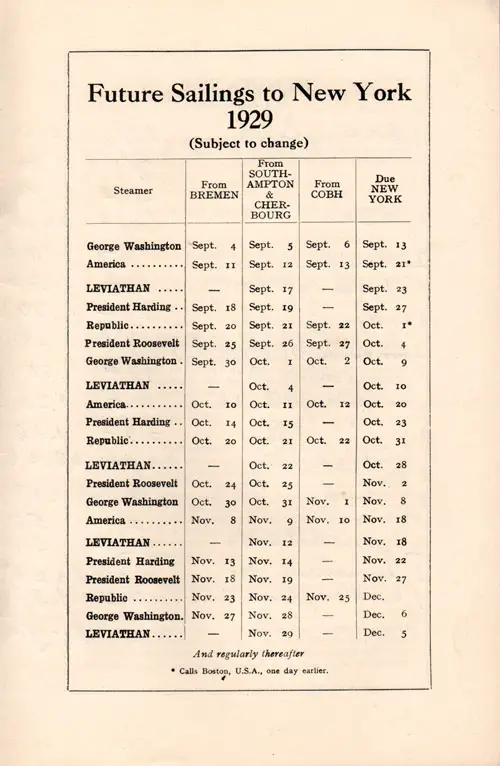
Westbound Sailing Schedule, Bremen-Southampton-Cherbourg-Cobh-New York, from 4 September 1929 to 5 December 1929. Ships included the America, America, George Washington, Leviathan, President Harding, President Roosevelt, and Republic. SS Leviathan Passenger List, 27 August 1929. | GGA Image ID # 1e1fddf5a8
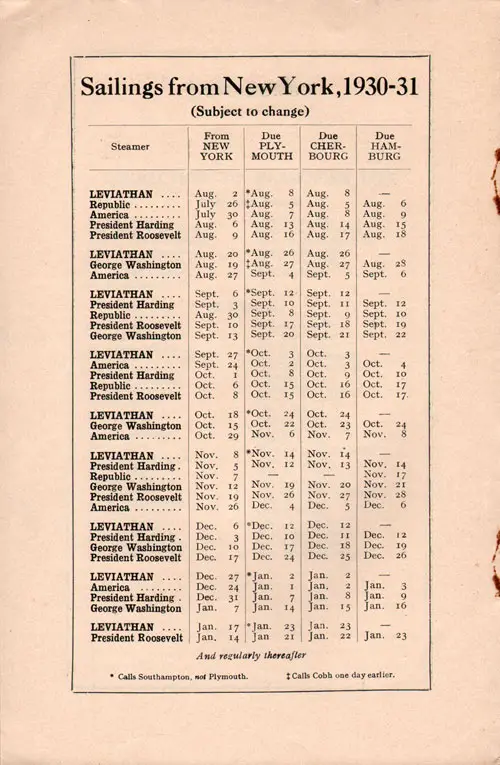
Eastbound Sailing Schedule, From New York to Plymouth, Cherbourg, and Hamburg, from 26 July 1930 to 23 January 1931. Ships Included the America, George Washington, Leviathan, President Harding, President Roosevelt, and Republic. SS George Washington Passenger List, 5 August 1930. | GGA Image ID # 1e8781a11e
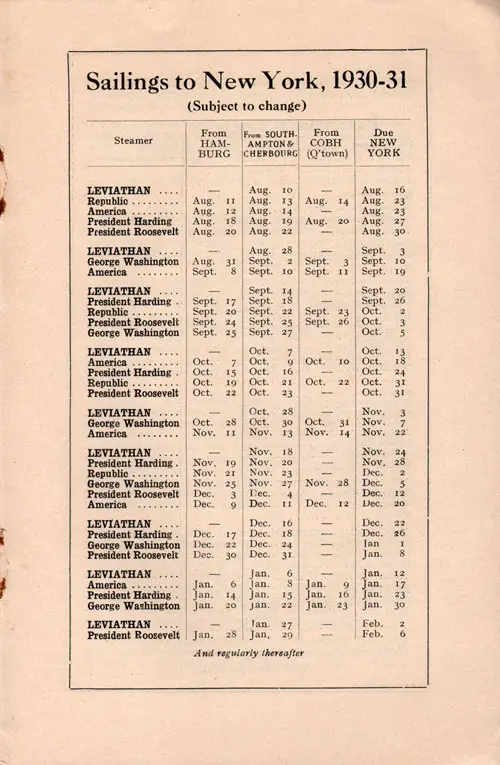
Westbound Sailing Schedule from Hambourg to Southampton, Cherbourg, Cobh (Queenstown), and New York, from 10 August 1930 to 6 February 1931. Ships Included the America, George Washington, Leviathan, President Harding, President Roosevelt, and Republic. SS George Washington Passenger List, 5 August 1930. | GGA Image ID # 1e877c72a1
Return to Content Links
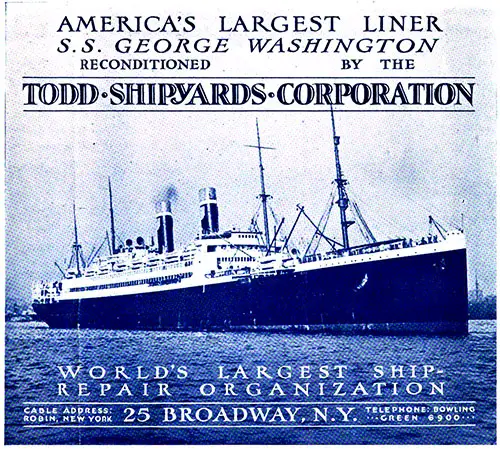
America's Largest Liner SS George Washionton Reconditioned by the Todd Shipsyards Corporation - World's Largest Ship Repair Organization, New York. 1921 Advertisement. | GGA Image ID # 141d89ce28
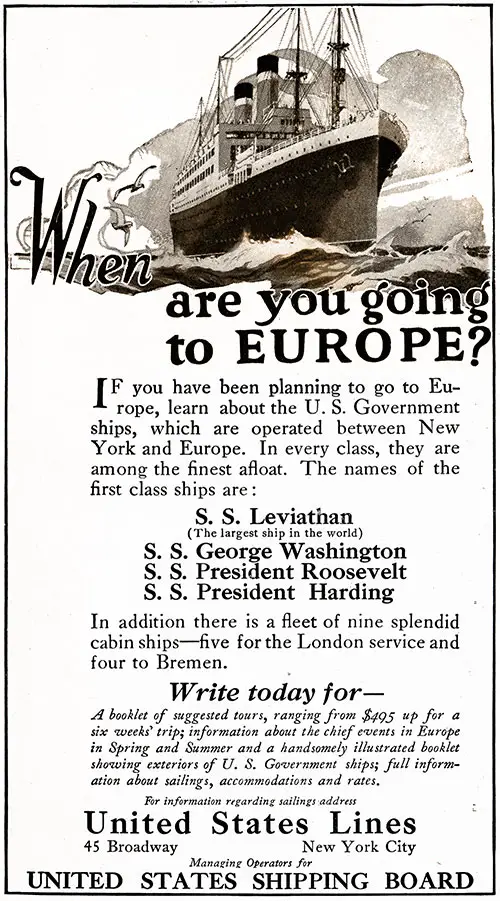
Advertisement (1923), United States Lines / United States Shipping Board. Ships Mentioned Include the SS Leviathan (The Largest Ship in the World), SS George Washington, SS President Roosevelt, SS President Harding. Ocean Records, May 1923. | GGA Image ID # 1e67be81f5
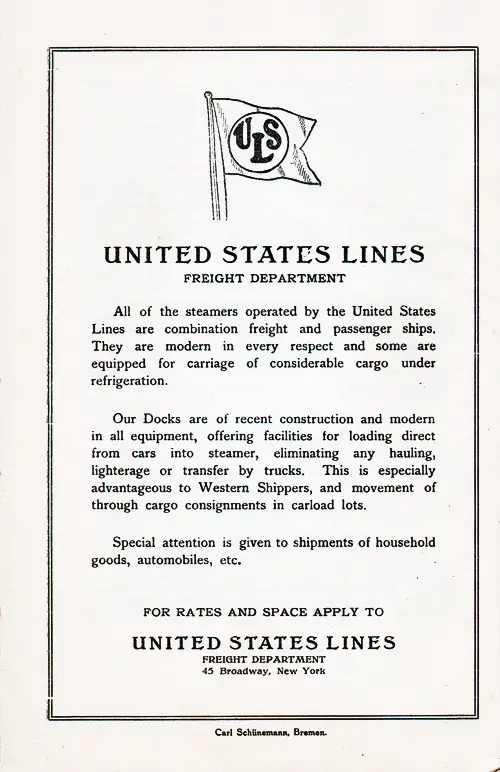
Advertisement: United States Lines Freight Department, 1924. SS George Washington Passenger List, 22 August 1924. | GGA Image ID # 1e86fcbac3
Return to Content Links
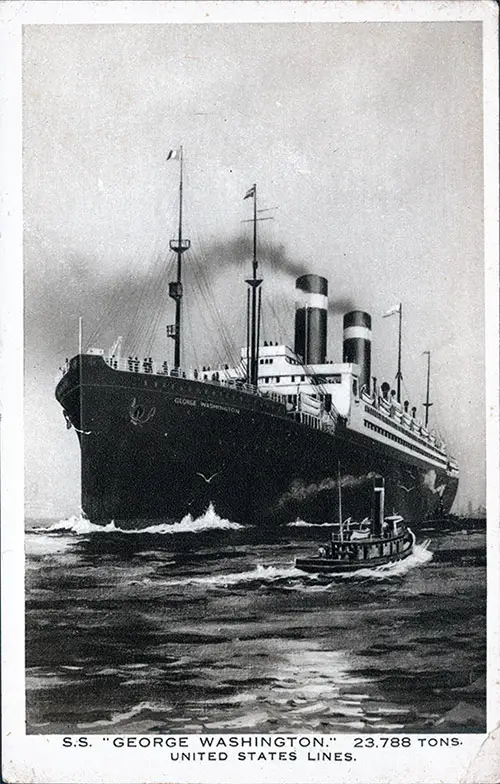
Vintage Postcard Features a Black & White Painting of the SS George Washington of the United States Lines, 23,788 Tons. nd circa 1920. | GGA Image ID # 167ff9eed7
Return to Content Links

Distinguished Liners from The Shipbuilder - 1906-1914 Volume 1
An authentic replication to the smallest detail of the best of The Shipbuilder magazine, 1906-1914, including articles on the Titanic, Olympic, Lusitania, Mauretania, and more. This encyclopedic collection contains original text, photographs, and advertisements, as well as 22 fold-out blueprint plans, five color plates, a two-color Titanic cutaway folding advertisement and even two facsimile subscription forms.

Doomed Ships: Great Ocean Liner Disasters
Naval historian William H. Miller, Jr. recounts the dramatic stories behind various ill-fated passenger ships. He takes readers beyond the newspaper headlines and formal inquiries, offering firsthand accounts of heroic rescues, daring escapes, and tragic losses.
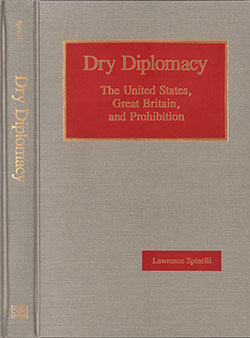
Dry Diplomacy: The United States, Great Britain, and Prohibition
American interference with international shipping--to disrupt what Presidents Harding and Coolidge deemed British alcohol smuggling--would lead to a diplomatic crisis in the mid-1920s.
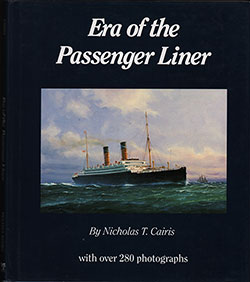
Era of the Passenger Liner - 1992
The Gilded Era comes back to life as the reader relives the careers of stately ships and express greyhounds from immigrant ships to floating palaces. Scarce, large format book containing 288pp. Features photographs, statistics, and background of 280 passenger liners, each with a picture.

Here is the story of twentieth-century passenger shipping, from the first of the superliners — the German Kaiser Wilhelm der Grosse — to Cunard's Queen Elizabeth and Queen Mary, right up to Queen Elizabeth 2.

The First Great Ocean Liners in Photographs - 1983
Sumptuous volume recalls the glorious early years of elegant transatlantic travel. Over 190 historic photographs depict exterior and interior views of 101 great ocean liners, including the Virginian, Imperator, Vaterland, Bismarck, Lusitania, Mauretania, Balmoral Castle, Titanic, Olympic, Aquitania and dozens more. Full captions.

The Great Liners: The Seafarers, Volume 4
A history of the world's famous luxury liners provides portraits of the ships. It examines such great disasters as the sinking of the Titanic. This edition explores the grand hotels that traversed the Atlantic between 1840 and 1930.

Great Passenger Ships of the World 1858-1912
This initial volume deals with Ships from 1858-1912, from the first passenger ship of over 10,000 GRT to be placed in service (the Great Eastern) to those unforgettable sister ships, the Olympic and Titanic — the first of more than 40,000 GRT.
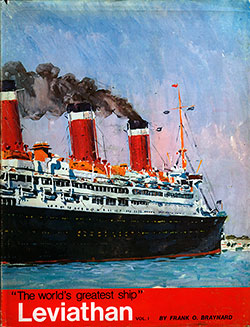
Leviathan: "The World's Greatest Ship" Volume 1
The first volume takes us from the construction of the VATERLAND to the end of World War One when the VATERLAND, now the U.S.S Leviathan, was used as a troop transport and packed with fabulous photographs and reproductions of newspaper articles.

Leviathan: "The World's Greatest Ship" Volume 2
Volume 2 picks up the LEVIATHAN saga during her monumental conversion from a troop ship to a luxury liner and carries the ship’s tempestuous life up through her first round trip as a U.S. express liner. The book finishes with the SS Leviathan's triumphant return to the Atlantic.

Majesty at Sea: The Four Stackers
The opulent and luxurious four-funnel passenger liners, of which only fourteen have ever been built, are unsurpassed in maritime history. Built between 1897 and 1921, these great vessels vied with each other in their standards of comfort, spaciousness, and speed, and great was the rivalry between their owners.

North Atlantic Passenger Liners Since 1900
Material about the most prominent steamship companies on the Atlantic Ferry today and those that have been there for some time. Some Lines have diverse services to other oceans, seas, and continents.

This book recreates the ambiance of the ocean linereraby showing the actual objects used on board. Each piece of ocean-liner memorabilia is like an aladdin's lamp, releasing wondrous memories of that grand style of travel.
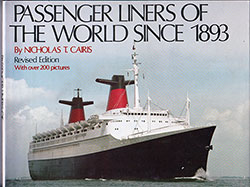
Passenger Liners of the World Since 1893
The author here takes a nostalgic look back to the heyday of the passenger ship, providing a brief history of 211 ships of over 10,000 tons, together with specifications and technical details of each.
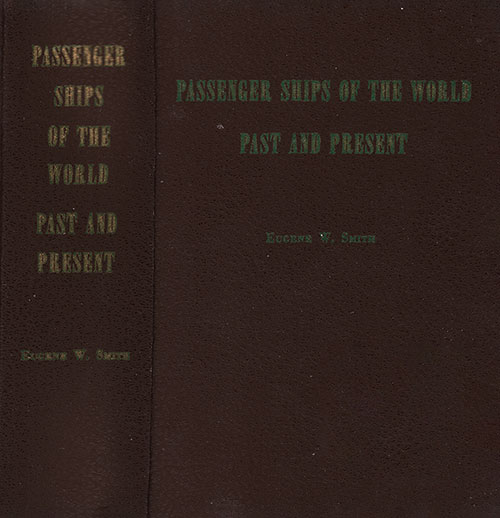
Passenger Ships of the World - 1963
🎓 “A Global Voyage Through Steamship History for Historians, Genealogists, and Maritime Enthusiasts”
Eugene W. Smith’s Passenger Ships of the World – Past and Present (1963) is a masterfully curated encyclopedic reference that charts the rise, peak, and transformation of ocean-going passenger ships through nearly two centuries. Expanding upon his earlier Trans-Atlantic and Trans-Pacific works, Smith offers a global maritime panorama that includes ships serving the Americas, Africa, Europe, Asia, Australia, and Oceania, as well as Canal routes and California-Hawaii shuttle lines.
🧭 This book is an essential resource for:
- Maritime historians seeking design evolution and fleet data
- Genealogists tracing voyages and shipping lines
- Educators and students studying transoceanic migration and tourism
- Ship modelers, naval architects, and enthusiasts interested in dimensions, tonnage, and speed

Picture History of American Passenger Ships - 2001
Loving tribute to luxury liners documents more than 100 ships, including the Leviathan, the America, the Independence, the President Polk, and the United States. Detailed captions provide tonnage, speed, size, and passenger load information.
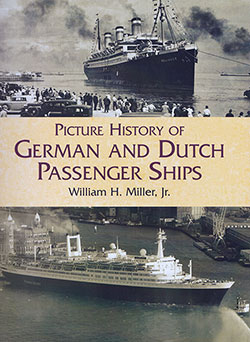
Picture History of German and Dutch Passenger Ships
Picture History of German and Dutch Passenger Ships is a superbly illustrated volume that documents a long line of great ships--from "floating palaces" such as the Imperator (1913) and the Vaterland (1914) to such luxurious cruise ships as the Statendam (1957), Hamburg (1969), the remodeled Bremen (1990), and the new Deutschland (1998).

Picture History of the SS United States
A comprehensive pictorial record of the SS United States that will appeal to maritime historians, this celebration of an American champion and centerpiece of national pride will also captivate ship lovers and anyone thrilled by sea travel.

This book provides, in a narrative free from technical terms, a complete history of the development of steamships, showing the evolution of the modern ocean greyhound from the earliest experiments in marine engineering. The illustrations form a unique feature of this handsome volume.
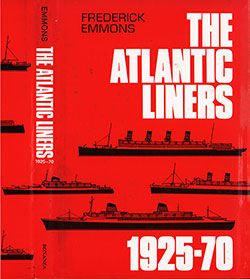
THE ATLANTIC LINERS will be cherished by all the millions of Americans who love the sea. Frederick Emmons sketches the histories of every ocean liner that sailed between the United States and Europe between 1925 and 1970.

US Steamships: A Picture Postcard History
Over many years, Postcards were collected for the message, history, and the scene. As a result of these collecting interests, we have a valuable source of information relating to many subjects, including steamships, from a historical, technical, and artistic perspective. The Postcards in this book provide a chronological history of U.S. Steamships.
Return to Content Links
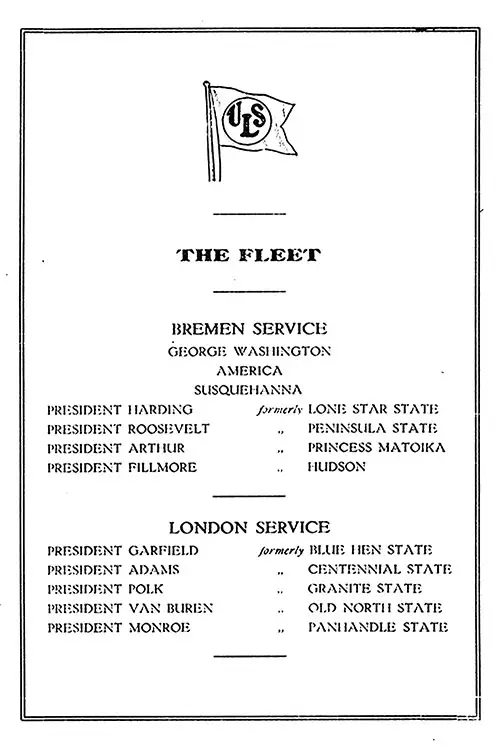
United States Lines Fleet List for Bremen and London Services, 1922. Bremen Service Ships Included the America, George Washington, President Arthur, President Fillmore, President Harding, and President Roosevelt. London Service Ships Included the President Adams, President Garfield, President Monroe, President Polk, and President Van Buren. SS America Passenger List, 12 July 1922. | GGA Image ID # 1e2d0848bb
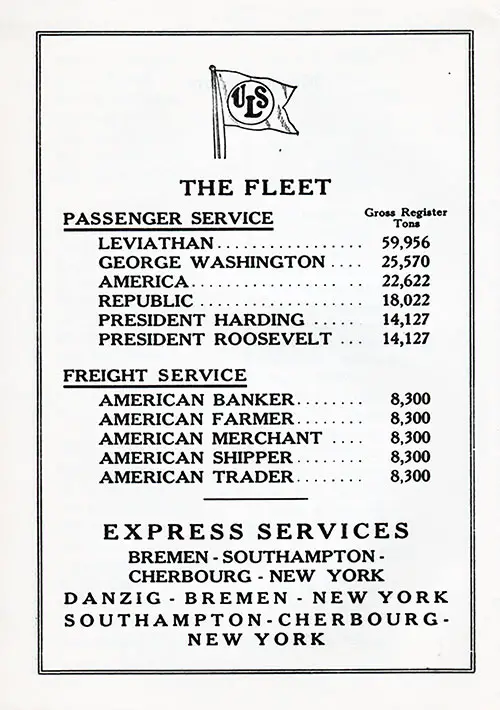
United States Lines Fleet List for Passenger and Freight Services, 1924. Passenger Ships Included the America, George Washington, Leviathan, President Harding, President Roosevelt, and Republic. SS America Passenger List, 27 July 1924. | GGA Image ID # 1e2dc18e1a
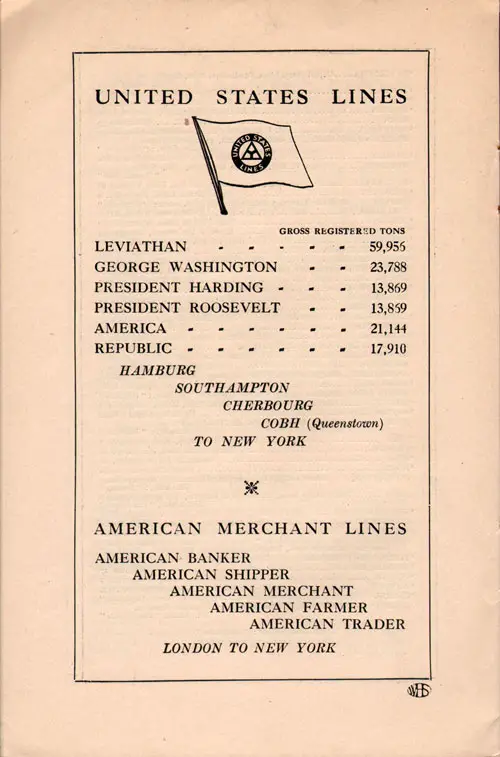
Fleet List, United States Lines and American Merchant Lines, 1930. SS George Washington Passenger List, 5 August 1930. | GGA Image ID # 1e876b53df
Return to Content Links
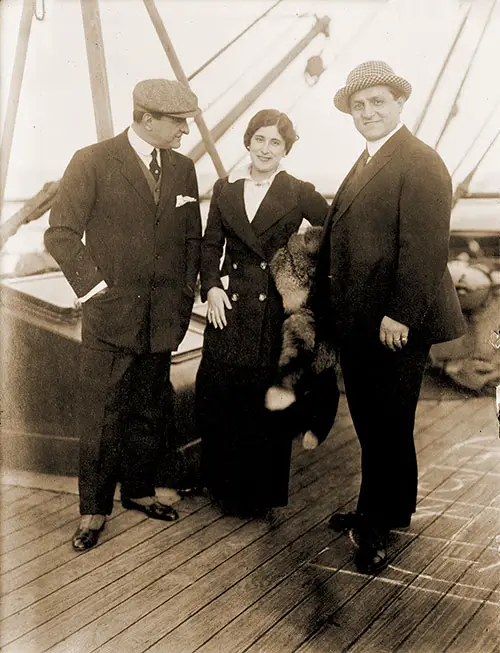
Italian opera singers Antonio Scotti (1866-1936), Lucrezia Bori (1887-1960), Pasquale Amato (1878-1942) arriving in New York on 28 October 1912 on the SS George Washington of the Norddeutscher Lloyd Bremen. Bain News Service. Library of Congress LC # 2014691868. | GGA Image ID # 1d7284d680
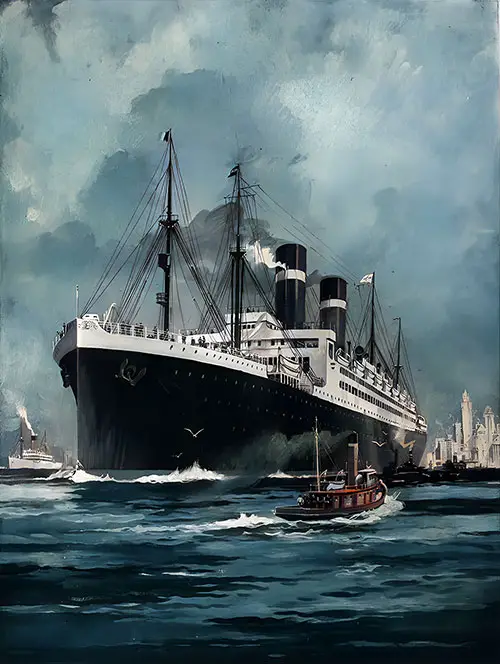
No History of the World War Would Be Complete Without a Reference to the Famous SS George Washington, Flag-Ship of the United States Lines Fleet. The George Washington Carried Thousands of Yankee Soldiers to France, and After the Armistice Was Signed, the Great Liner Took the Delegation of the United States to the Peace Conference. This Vessel Is 722 Feet Long, with a Gross Registered Tonnage of 23,788. USL Passenger Ships Brochure, 1922. | GGA Image ID # 11fa4b660a
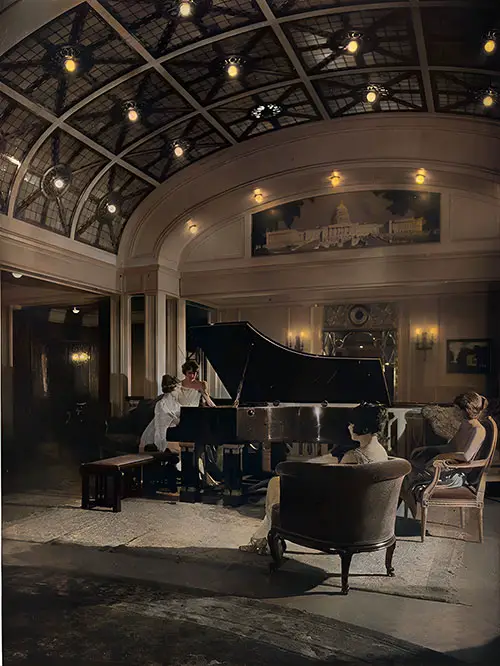
A Spacious Lounge Found on the SS George Washington. Human Nature Reacts Readily to an Environment of Repose and Refinement. This Principle Was Born in Mind in the Interior Arrangement and Decoration of the George Washington. Everything Is in Perfect Taste. The Spacious Lounge Is Reminiscent of the Formal Dignity of Mount Vernon. USL Passenger Ships Brochure, 1922. | GGA Image ID # 11fa5e073a
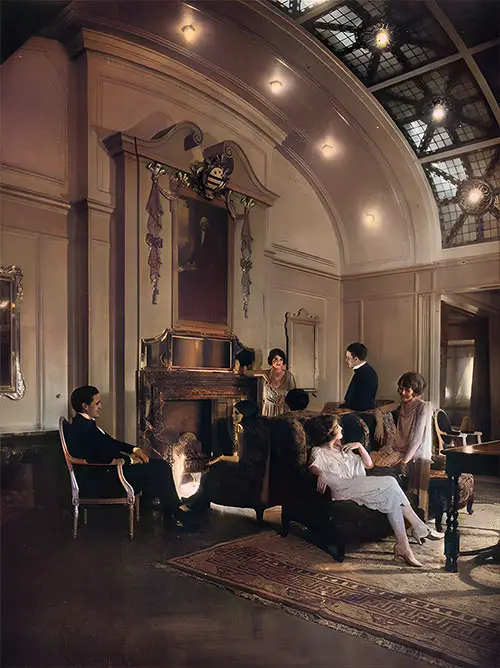
First Class Lounge on the SS George Washington. Comfort and Elegance Are Not Necessarily Opposed to Each Other. In This Fireside Scene in the Lounge of the SS George Washington, One Sees an Admirable Combination of the Two Qualities. The Pieces of Furniture Are Works of Art in Themselves, yet the Deep Cushioned, Wide-Armed, Reposeful Chairs Suggest the Complete Relaxation Essential to a Vacation. USL Passenger Ships Brochure, 1922. | GGA Image ID # 11fa61468a
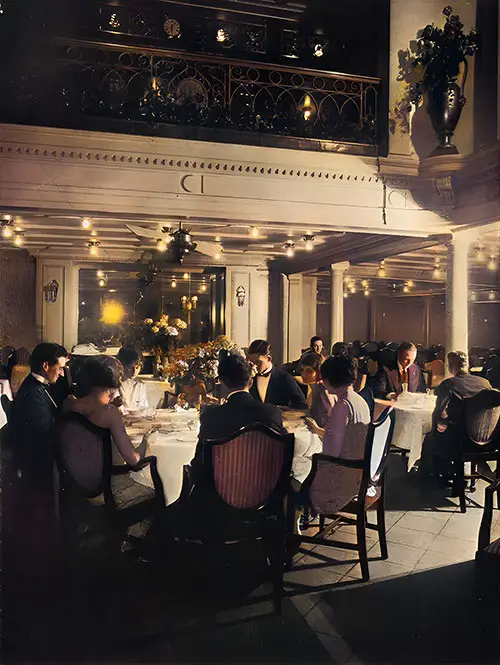
First Class Dining Saloon on the SS George Washington. One Day on Deck, Where the Brisk, Salt Air of the Sea Sweeps in Through the Nostrils and Permeates the Whole Being, Makes Even the Chronic Invalid Forget His Rules of Diet and Rediscover the Keen Relish of Early Youth. The Passengers Look Forward to the Dinner Hour on the SS George Washington. USL Passenger Ships Brochure, 1922. GGA Image ID # 11fa973b8f
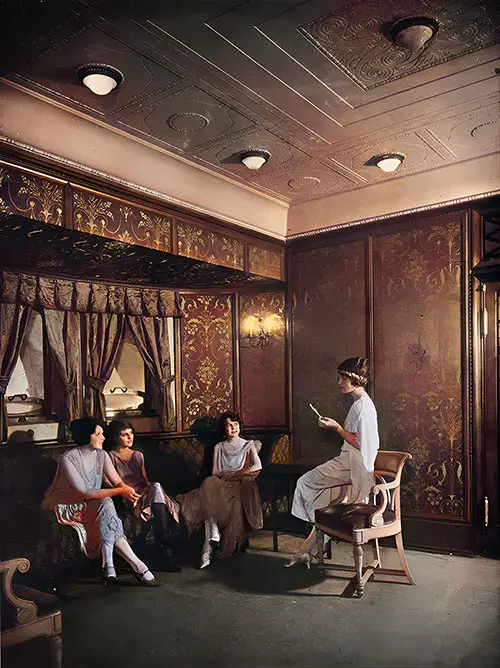
First Class Social Hall on the SS George Washington. As Richly Ornamented as Some Medieval Mosaic Is the Anteroom of the Social Hall on the George Washington. Decorated in the Exquisite Renaissance Style with Gold Figures on Dark-Stained Panels, It Stands out as a Faultless Specimen of the Artist's Craftsmanship. Every American Has the Right to Expect Surroundings Such as These on His Own Ships. USL Passenger Ships Brochure, 1922. | GGA Image ID # 11facd2a89
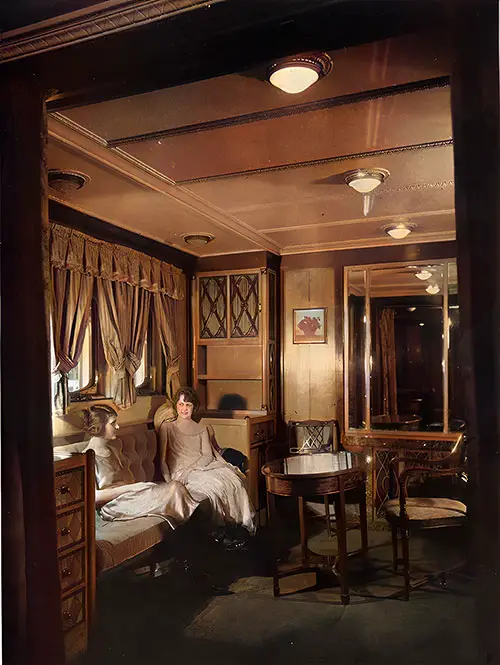
The Presidential Suite Is a Unique Feature of the SS George Washington. This Apartment Was Occupied by President Wilson When He Journeyed to Europe to participate in the Peace Conference. The King and Queen of Belgium Are Among the Many Other Notables Who Have Been Guests in These Luxuriously Comfortable Rooms. USL Passenger Ships Brochure, 1922. | GGA Image ID # 11fbfd74d7
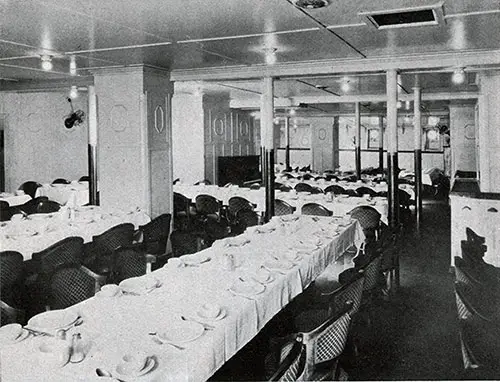
Third Class Dining Saloon on the SS George Washington. USL Third Class to Europe Brochure, 1923. | GGA Image ID # 11cecd990b
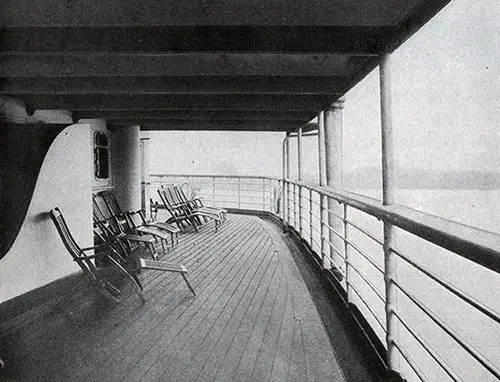
View of the Third Class Deck on the SS George Washington. USL Third Class to Europe Brochure, 1923. | GGA Image ID # 11d16e781e
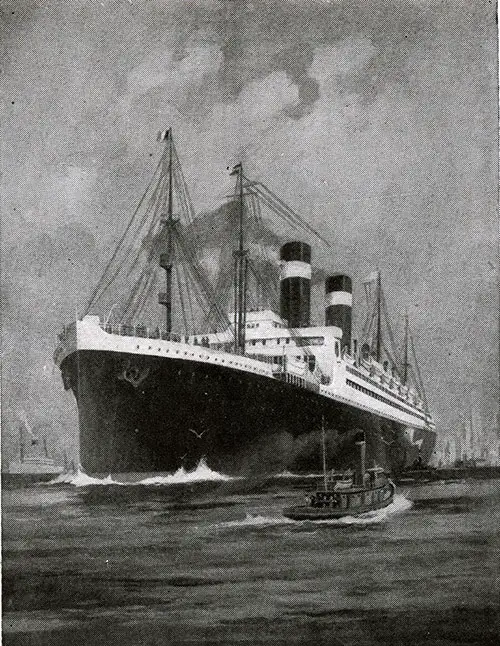
The Steamship George Washington. Next to the Leviathan, the Largest Liner Under the American Flag. USL Third Class to Europe Brochure, 1923. USL Brochure 1920s. | GGA Image ID # 11d2bf209c
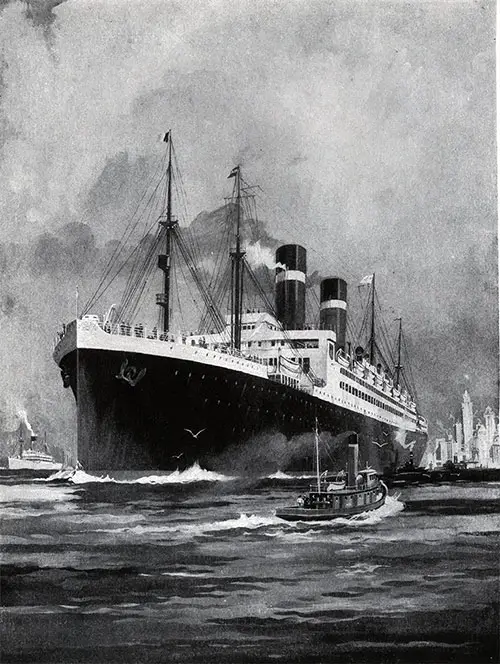
SS George Washington of the USL. The stately George Washington is 722 feet long and has a gross registered tonnage of 25,570. This great liner is a veritable floating hotel and is outstandingly one of the most popular liners in the transatlantic passenger service. USL Brochure 1920s. | GGA Image ID # 12475a6ead
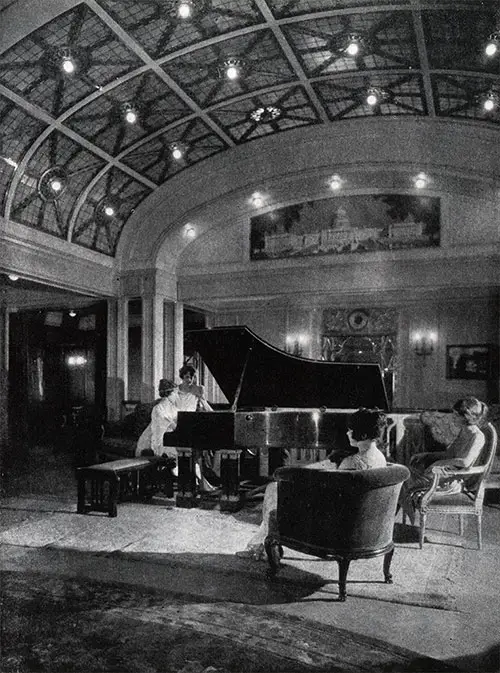
First Class Lounge on the SS George Washington of the USL. The spacious Lounge, luxuriously furnished, carries with it an unmistakable atmosphere of repose and refinement in keeping with the entire scheme of interior decoration. An open fireplace and cozy corners in the Lounge provide a soothing touch to the beauty of the room. USL Brochure 1920s. | GGA Image ID # 1247a7b00e
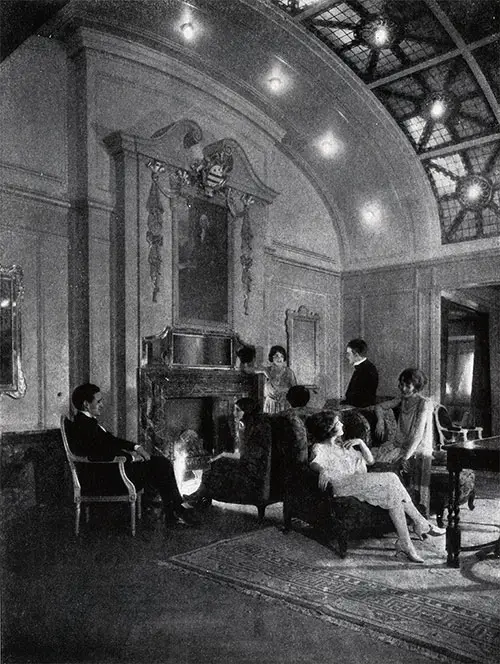
First Class Social Hall on the SS George Washington. Another corner of the Social Hall showing the exquisite detail of the Colonial handling, great open fireplace, and the famous picture of our first President. It is essentially like the drawing-room of a stately Georgian palace with its refined social life. USL Brochure 1920s. | GGA Image ID # 12482eba14
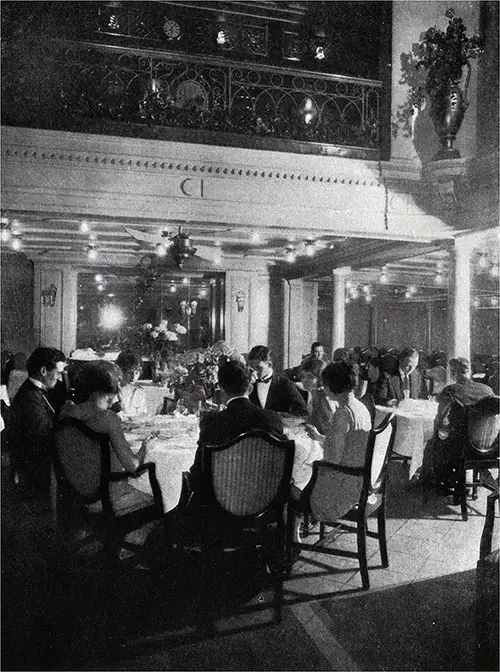
First Class Dining Saloon on the SS George Washington. One of the most talked of features is the cuisine. It is in charge of a skilled staff of chefs and faultlessly sewed amid the surroundings whose luxury and faultless taste of appointment is the equal of any American Hotel standard. USL Brochure 1920s. | GGA Image ID # 12483dc4d5
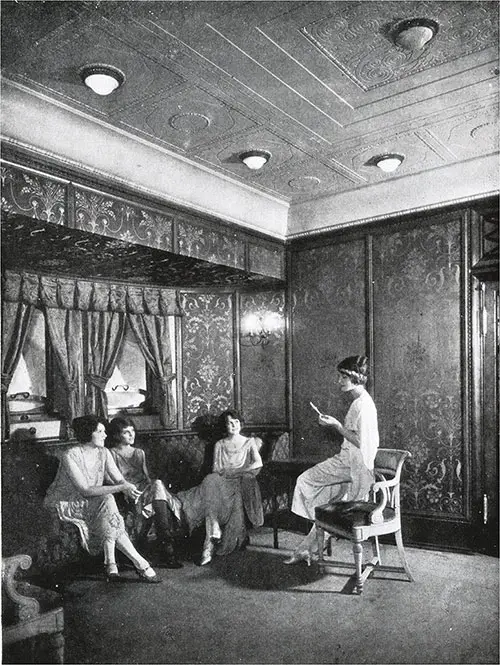
First Class Passengers Enjoy the Social Hall on the SS George Washington. The adjoining rooms of the Social Hall are decorated in the exquisite Renaissance style with gold figures on dark stained panels. They are perfect specimens of artistic craftsmanship and rare beauty, usually only found in the mansions of the very wealthy. USL Brochure 1920s. | GGA Image ID # 12489af5da
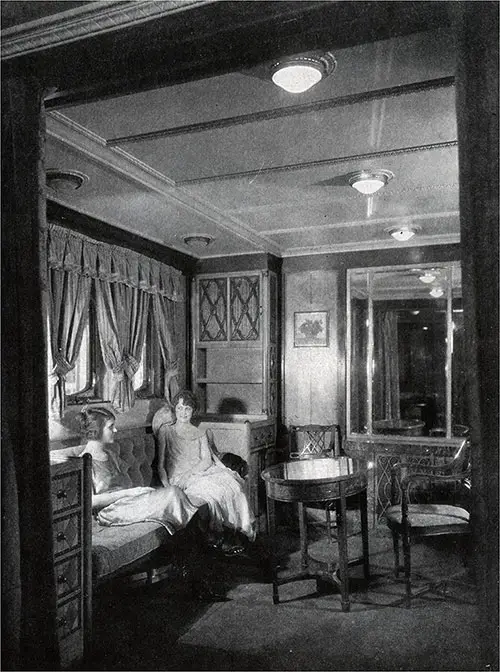
First Class Presidential Suite on the SS Georgic Washington. The Presidential Suite is a unique feature of the SS George Washington. This apartment was occupied by President Wilson when he went to Europe for the Peace Conference. It is an excellent example of the lengths to which modern shipbuilders have provided the utmost in luxury. USL Brochure 1920s. | GGA Image ID # 1248eca86f
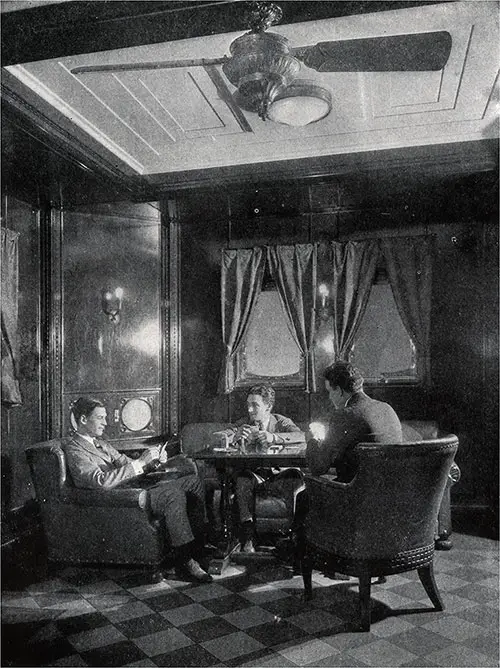
First Class Smoking Room on the SS George Washington. In this big wood-paneled Smoking Room with large windows looking out over the open sea, men on board will find an ideal lounging place. Here men can relax, play cards, smoke, tell stories, talk, or read in peace. You will always find friendly fellowship here. USL Brochure 1920s. | GGA Image ID # 1248eef138
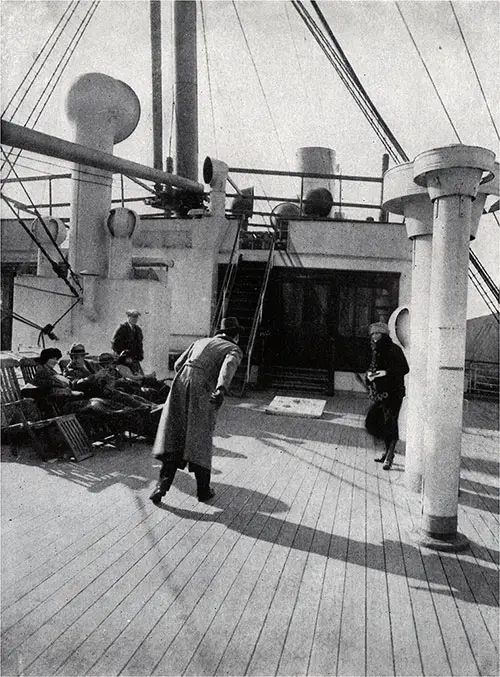
First Class Passengers Enjoy Playing Deck Games on the SS George Washington. You will probably spend most of your time at sea on the broad, sunny decks. Here you will be supplied with the equipment for all the many Hands of "deck sports"—deck tennis and golf, shuffleboard and quoits. Impromptu dances are also held here. USL Brochure 1920s. | GGA Image ID # 124929e4c5
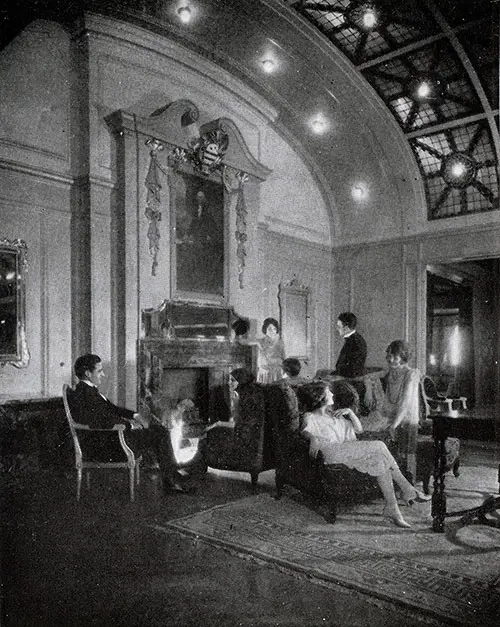
First Class Social Hall on the SS George Washington. The America Way to Europe Brochure, 1924. | GGA Image ID # 11ffea0c9a
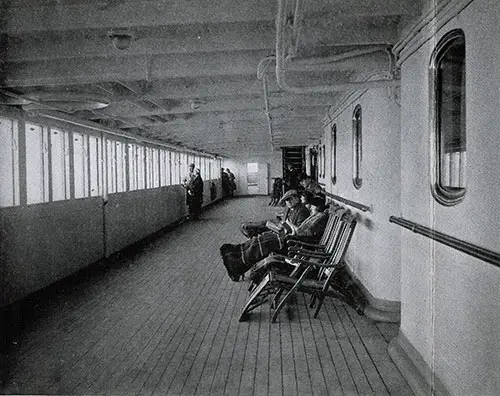
Enclosed Deck for First Class Passengers on the SS George Washington. The America Way to Europe Brochure, 1924. | GGA Image ID # 11ff8e6afc
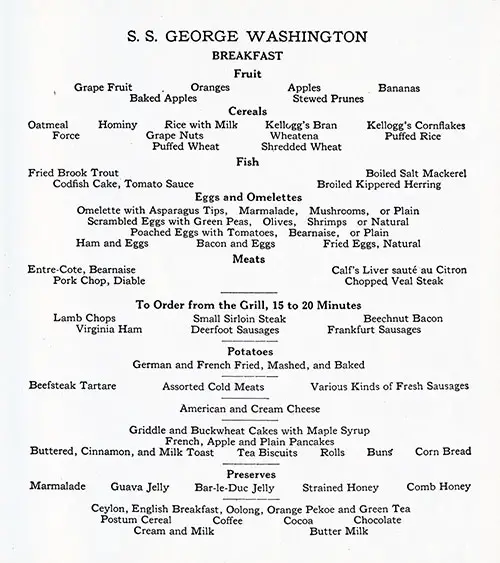
Sample First Class Breakfast Menu from the SS George Washington. The America Way to Europe Brochure, 1924. | GGA Image ID # 1201e04410
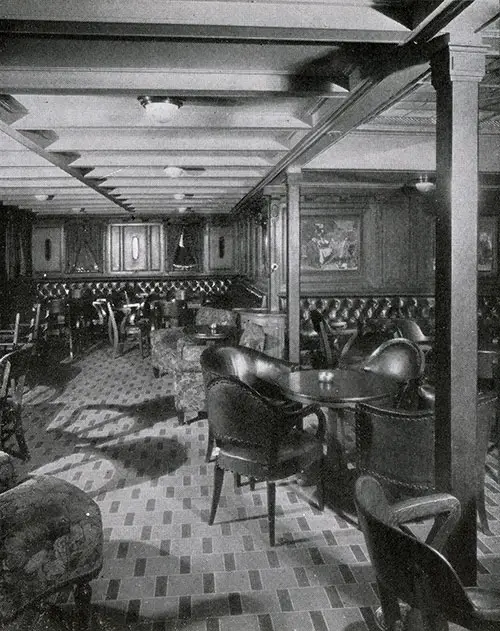
Second Cabin Smoking Room on the SS George Washington. The America Way to Europe Brochure, 1924. | GGA Image ID # 1202012bbb
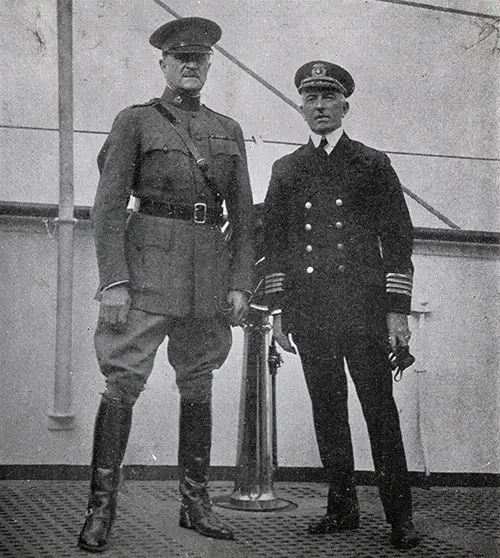
General Pershing and Captain Cunningham on the Bridge of the Great Liner SS George Washington. The America Way to Europe Brochure, 1924. | GGA Image ID # 1203b1b90b
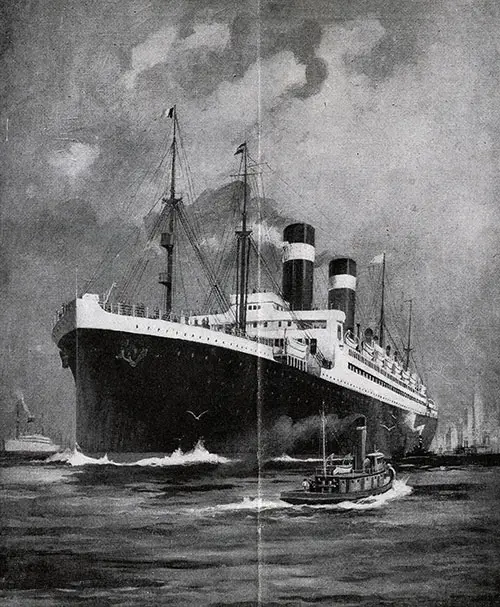
The SS George Washington of the United States Lines. The America Way to Europe Brochure, 1924. | GGA Image ID # 1204ba8405
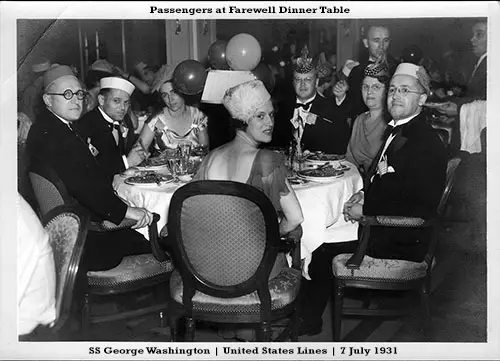
Group of Dinner Guests at Farewell Dinner Table on Board the SS George Washington of the United States Lines, 7 July 1931. | GGA Image ID # 1e8808345c
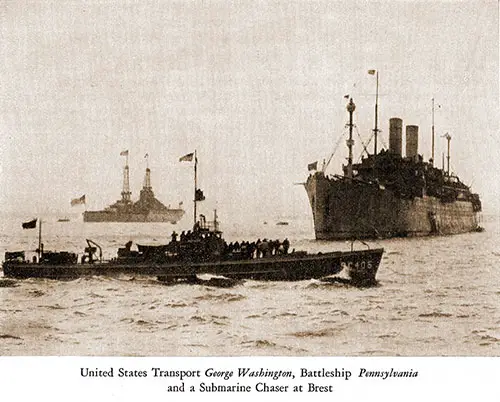
United States Transport SS George Washington, Battleship USS Pennsylvania, and a Submarine Chaser at Brest. American Armies and Battlefields, 1938. | GGA Image ID # 1e880a793b
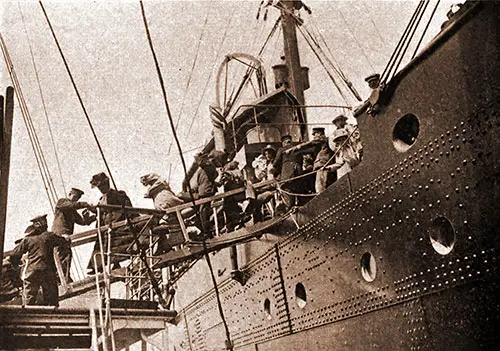
Passengers of the SS George Washington of the North German Lloyd Disembarking at Plymouth, England. Handbook of Travel, 1910. | GGA Image ID # 1797cc171f
Return to Content Links
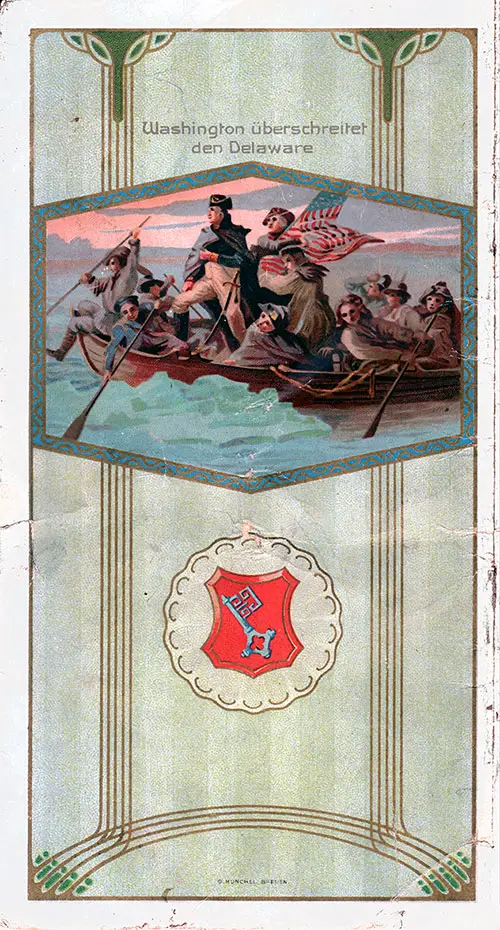
Back Cover, Norddeutscher Lloyd SS George Washington Passenger List, 20 May 1911. | GGA Image ID # 1e85d73abe
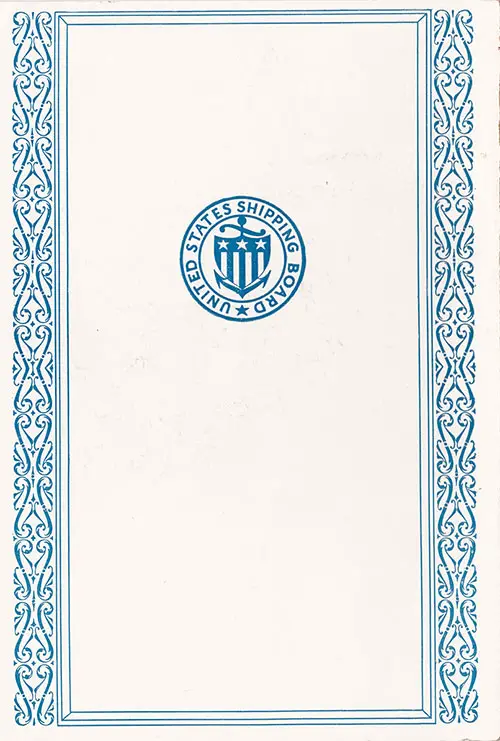
Back Cover, Tourist Third Cabin Passenger List from the 19 May 1928 Voyage of the SS George Washington of the United States Lines. | GGA Image ID # 1651c7705d
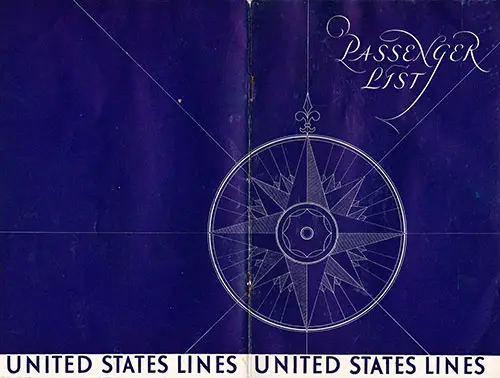
Front and Back Cover, United States Lines SS George Washington Cabin Class Passenger List - 25 September 1930. | GGA Image ID # 16526a0523
Return to Content Links
Information for Passengers - 20 May 1911
The object of the following rules being to provide for the comfort and safety of passengers, their strict observance is urgently requested.
Meals. First Saloon passengers are served in the large Dining Room.
Breakfast from 7.30 a. m. to 10:00 am, Lunch from 12 noon to 2:00 pm, Dinner from 6:00 pm to 8:30 pm
Meals are served d la carte at any time during the above mentioned hours at small tables for 2—4, 5, 6—7 persons. Besides this, a fixed menu is served both at lunch and dinner. Any particular wishes with regard to special dishes will be satisfied so far as circumstances permit. Passengers are requested to apply to the Chief Steward in this respect.
Children are served in the Childrens’ Dining Room. Breakfast 8:00 am to 10:00 am, Lunch at 12 noon, Dinner at 6:00 pm
Servants, not attending the children, are served in the Childrens’ Dining Room. Breakfast from 8:00 am to 10:00 am, Lunch at 1:00 pm, Dinner at 7:00 pm
Tables, as well as seats, may be reserved beforehand upon application to the Chief Steward.
Meals are not served in the cabin or on deck, unless the passenger is prevented through sickness from coming to the Dining Room.
A good selection of various drinks at moderate prices is carried on board. Drinks brought on board by the passengers will not be served in the Dining Room.
The Dining Room is closed after 11:00 pm
The Reading and Social Rooms are opened to the passengers until 11:30 pm The Vienna Cafes and Smoking Room are closed at midnight, the bars at 11:45 pm
Baggage: Only small parcels and hand-baggage in limited quantity are permitted to be taken into the staterooms. Trunks and other bulky articles must be stored in the baggage-room to which passengers have daily access if accompanied by an officer or the baggage master.
Money, valuables, documents etc., duly sealed or carefully envelopped and provided with the name of the owner, may be handed to the Purser for safe keeping during the voyage, but without any guarantee on the part of the Company. The Purser will give a receipt on demand.
On the steamers “Kaiser Wilhelm der Grosse”, “Kronprinz Wilhelm”, “Kaiser Wilhelm II.”, “Kronprinzessin Cecilie”, “George Washington” and “Prinz Friedrich Wilhelm” cabin passengers may place their valuables in safes which are placed at their disposal against payment of a small rental.
Library: There is a library on board at the disposal of the 1. and II. cabin passengers. A list of the books will be found in the Saloons.
Bath-rooms: Passengers wishing to make use of the bath-rooms are requested to write their name and the hour of bathing upon the list in the antechamber to the bathrooms.
Doctor. There is a duly qualified Doctor on board who will attend, free of charge, to passengers falling sick during the voyage. However, the physician is justified in asking for his fee from those I. cabin passengers who come on board ill.
Barber and Ladies hair dresser. A fixed tariff is to be consulted in the Barber’s room. A similar tariff is to be found in the Ladies’ Hair Dressing Saloon.
Cigars, cigarettes and playing cards are obtainable in the Smoking Room at fixed prices.
Smoking is permitted only in the Smoking-rooms and on deck. It is strictly prohibited to smoke below deck, in the saloons or in the state-rooms.
Correspondence. Telegrams and cables to be despatched from the ports of call are to be handed to the Purser. Wireless messages are to be given in at the special wireless telegraph office on board ship.
Letters and post cards may be posted at any of the post boxes on board. The time of collection is indicated on the boxes.
The universal Postal Union regulations apply to the mail posted on board.
20 Pf. German stamp for letters 10 Pf. German stamp for postal cards.
Postal stamps are obtainable either at the Post Office on board or from the stewards in the Smoking and Writing Rooms.
The Chief Steward is charged with the distribution of incomingpost. Parcels are delivered either by the Baggage Master or by the sea-post officials.
In their own interest, passengers should call upon the Chief Steward before leaving the steamer to enquire whether any correspondence is awaiting them, or to leave their address for later despatches.
Letters and telegrams may be directed in c/o any of the company’s agents.
Deck Wind shelters. Special attention is called to the Wind shelters provided on the upper Promenade Deck of the Express Steamers, enabling passengers to remain comfortably on deck even in severe weather.
This new invention is patented in all countries.
Pastimes and games are provided on board.
Deck chairs and traveling rugs information can be found below.
Service. Passengers are requested in their own interest, to submit any complaints they may have to make to the captain at the time of his daily round.
Passengers are requested to comply with the orders of the Captain and/or his officers who are responsible for both the safety of the ship and passengers and the comfort and order on board.
Change of Cabins. Passengers desiring to change their Cabins during the voyage are requested to apply to the purser, who has charge of the vacant accommodation.
Deck chairs and Travelling rugs.
Deck chairs can be hired of the Norddeutscher Lloyd its principal agents or on board. The charge for each chair for the voyage to New York is $ 1 = 4 s. 0 d. = Marks 4 = Frs. 5 each.
Travelling rugs can be hired of the Deck stewards at a charge of Marks 4 each for the voyage.
A guarantee that the rug has been chemically cleaned and not since used is only implied when it is taken out of its sealed paper-wrapper in the presence of the hirer.
Source: SS George Washington Passenger List - 20 May 1911
Information for Passengers - 1 June 1912
Traffic Office
At this office on board Passengers are furnished with information regarding travel in general.
The TRAFFIC Office is open: for First Cabin Passengers from 10:00 am to 12 noon and " 4:00 pm " 6:00 pm
The official of the Traffic Office will hold himself at the disposal of the Second Cabin Passengers from 9:00 am to 10:00 am and " 3:00 pm " 4:00 pm in the Second Class Smoking Room.
Deck chairs and Travelling rugs
Deck Chairs of the O. C. C. can be hired of the Norddeutscher Lloyd, Kayiten-Abteilung, its principal agents, or on board. The charge for each chair for the voyage to New York is s 1 = sh 4 = Marks 4 = Frs. 5.
Travelling Rugs can be hired of the Deck stewards at a charge of s 1 = sh 4 = Marks 4 = Frs. 5 each for the voyage.
A guarantee that the rug has been chemically cleaned and not since used is only implied when it is taken out of its sealed paper wrapper in the presence of the hirer.
Information for Cabin Passengers.
The object of the following rules being to provide for the comfort and, safety of Passengers, their strict observance is urgently requested.
Passengers are requested to comply with the orders of the Captain and/or his officers who are responsible for both the safety of the ship and Passengers and the comfort and order on board.
Meals. First Saloon Passengers are served in the large Dining Room.
Breakfast from 7.30 a. m. to 10:00 am, Lunch from 12 noon to 2:00 pm, Dinner from 6:00 pm to 8:30 pm
Meals are served à la carte at any time during the above mentioned hours at small tables for 2-4, 5, 6-8 persons. Besides this, a fixed menu is served both at lunch and at dinner. Any particular wishes with regard to special dishes will be satisfied so far as circumstances permit. Passengers are requested to apply to the Chief Steward in this respect.
Children are served in the Childrens' Dining Room. Breakfast 8:00 am to 10:00 am, Lunch at 12 noon, Dinner at 6:00 pm
Servants, not attending the children, are served in the Childrens' Dining Room. Breakfast from 8:00 am to 10:00 am, Lunch at 1:00 pm, Dinner at 7:00 pm
Tables, as well as seats, may be reserved beforehand upon application to the Chief Steward.
Meals are not served in the cabin or on deck, unless the passenger is prevented through sickness from coming to the Dining Room.
A good selection of various drinks at moderate prices is carried on board. Drinks brought on board by the Passengers will not be served in the Dining Room.
The Dining Room is closed after 11:00 pm
The Reading and Social Rooms are opened to the Passengers until 11:30 pm.
The Vienna Cafés and Smoking Room are closed at midnight, the bars at 11:45 pm
Baggage: Only small parcels and hand baggage in limited quantity may be taken into the staterooms. Trunks and other bulky articles must be stored in the baggage-room, to which Passengers have daily access if accompanied by an officer or the baggage master.
Money, valuables, documents etc., duly sealed or enclosed in an envelope bearing the name of the owner, may be handed to the Purser for safe keeping during the voyage, but without any guarantee on the part of the Company. The Purser will give a receipt on demand. On the steamers "Kaiser Wilhelm der Grosse", "Kronprinz Wilhelm", "Kaiser Wilhelm II.", "Kronprinzessin Cecilie", "George Washington" and "Prinz Friedrich Wilhelm" cabin Passengers may place their valuables in safes which are placed at their disposal against payment of $ 1.— =- Marks 4.—.
Library: There is a library on board at the disposal of the First and Second cabin Passengers. A list of the books will be found in the Saloons.
Bathrooms: Passengers wishing to make use of the bathrooms are requested to write their names and the hour of bathing upon the list in the antechamber to the bathrooms.
Doctor. A duly qualified Doctor is on board who will attend, free of charge, to Passengers falling sick during the voyage. However, the physician is entitled to ask for his fee from those First cabin Passengers who come on board ill.
Barber and Ladies Hair Dresser. A fixed tariff is to be consulted in the Barber's room. A similar tariff is to be found in the Ladies' Hair' Hair Dressing Saloon.
Cigars, Cigarettes and Playing Cards are obtainable in the Smoking Room at fixed prices.
Smoking is permitted only in the Smoking-rooms and on deck. It is strictly prohibited below deck, in the saloons or in the staterooms.
Correspondence. Telegrams and cables to be despatched from the ports of call are to be handed to the Purser. Wireless messages are to be given in at the special wireless telegraph office on board ship.
Letters and post cards may be posted at any of the letter boxes on board. The time of collection is indicated on the boxes.
The Universal Postal Union Regulations apply to the mail posted on board.
20 Pf. German stamp for letters on steamers sailing
10 Pf. German stamp for postal cards f towards America. 5 Cts. U. S. A. postal stamp for letters Il on steamers sailing
2 Cts. U. S. A. postal stamp for towards Europe.
Postal Cards: Postal stamps are obtainable either at the Post Office on board or from the stewards in the Smoking and Writing Rooms.
The Chief Steward is charged with the distribution of incoming post. Parcels are delivered either by the Baggage Master or by the sea-post officials.
In their own interest, Passengers should call upon the Chief Steward before leaving the steamer both to enquire whether any correspondence is awaiting them and to leave their address for later despatches.
Letters and telegrams may be directed in c o any of the company's agents.
Deck Wind Shelters. Special attention is called to the Wind shelters provided on the upper Promenade Deck of the ExpresS Steamers, enabling Passengers to remain comfortably on deck even in severe weather. This new invention is patented in all countries.
Pastimes and Games are provided on board.
Deck Chairs and Travelling Rugs: see page 19.
Service. Passengers are requested in their own interest, to submit any complaints they may have to make to the captain at the time of his daily round.
Change of Cabins. Passengers desiring to change their Cabins during the voyage are requested to apply to the Purser, who has charge of the vacant accommodation.
Wireless Telegraphy on Board
The Wireless Telegraph station on board this steamer is in daily touch with all parts of the World, either through the Coast Stations direct, or indirectly through the medium of passing steamers. The names of the Coast Stations, as well as those of the steamers with which connection is expected during the day, are made known to Passengers by means of notices posted up in various parts of the ship.
Besides ordinary wireless messages, so-called "ocean letters" can be sent from the ship at comparatively low rates. The message is transmitted by wireless telegraphy to a steamer sailing in the opposite direction, taken by it to its next port of call and thence forwarded to the addressee by post.
Such letter-telegrams cannot be transmitted To Passengers.
All particulars respecting modes of transmission, duration, tariff, etc. can be obtained on application at the station on board.
All enquiries, complaints, etc. must be addressed to the German Wireless Telegraphy Co. Ltd., Tempelhofer Ufer 9, Berlin SW 61, which is entrusted with the Wireless Telegraphy Service on all the ships of the North German Lloyd. The Norddeutscher Lloyd assumes no responsibility whatever in respect of the Wireless Telegraphy Service.
Packing and Marking of Baggage. The baggage of Passengers must contain only their personal effects (linen, clothing, etc.). Household goods, etc. are not regarded as baggage and are liable to be shipped as merchandise. All baggage for shipment should be recognizable as such and must be labeled with the Company's steamer labels properly filled in. It should also be marked "Cabin" or "Hold", as the case may be.
The necessary printed labels will be supplied to Passengers by the Company or their Agents upon application.
Liability of the Norddeutscher Lloyd. The Company will only be liable for damage to, delay in delivery, or loss of baggage carried in the baggage room of the ship, and than only provided such damage delay or loss is occasioned by the fault of the Company. In any case the Company will not be responsible beyond the following sums
- • 20.-- per package in case of a first Class passenger
- • 10.— per package in case of a second Class passenger
- • 5.— per package in case of a third Class passenger,
unless a higher value has been declared before or at the time of the issue of the passage contract, or before or on delivery of the luggage to the Company, and provided that the special charge of one percent upon the excess df value so declared has been paid.
Claims for Lost, Damaged or Delayed Baggage must be made during the voyage to the Captain of the steamer, or to the Norddeutscher Lloyd or its representatives immediately after the arrival of the steamer and before possession is taken of the baggage. Unless this be done, no claim can be entertained.
Baggage must not contain Merchandise, money bonds, jewels, valuables or works of art, and the Norddeutscher Lloyd declares itself free of all liability in respect of such articles. Valuables should be handed over to the Purser of the ship for safe keeping during the voyage.
Wine, Beer, or Spirits must not be taken on board by Passengers, as they may be obtained on board at tariff prices.
It is strictly prohibited to bring on board explosives, or goods of a .dangerous or damaging nature, and Passengers contravening this will be made responsible for all damage, and may be legally proceeded against.
For Cabin Hand Baggage and articles which remain during the voyage in the care and custody of the Passengers, as well as for baggage not labeled with the Company's steamer labels properly filled in by the Passengers themselves, the Norddeutscher Lloyd disclaims all responsibility.
Travellers' Cheques and Letters of Credit.
The increasing popularity of these arrangements has led the Norddeutscher Lloyd considerably to extend the system.
Intending Passengers have now the following at their disposal according to the starting point or destination of their journey:
Internationale Reiseschecks, in Marks (in denominations of ,./6 50, 100 and 200), issued in Germany.
Travellers' Checks, in Dollars (in denominations of 10, 20, 50, 100 and 200) issued in the United States.
Mandats de Voyage, in Francs (in denominations of Frs. 50, 100 and 200) issued in France, Belgium, Switzerland, Italy and other countries of the Latin Union.
Circular Notes, in £ Sterling (in denominations of 5, 10 and 20) issued in all the countries of the world.
All of these can be cashed without deduction at any of the 5000 offices mentioned in the list of correspondents.
Letters of Credit will be issued for such amounts as may be desired, payment of which will be made by any agent of the Norddeutscher Lloyd.
Further information will be willingly supplied on application to the Norddeutscher Lloyd, Central-Abteilung, Bremen or to any agent of the Company.
Warning against professional Gamblers: The North German Lloyd desires to call the attention of the traveling public to the fact that certain persons, believed to be professional gamblers, are in the habit of traveling to and fro in transatlantic steamships.
The North German Lloyd, while not wishing to interfere in the slightest degree with the freedom of action of the patrons of its Line, invites their assistance in discouraging games of chance as being likely to afford these individuals special opportunities to take unfair advantage of others.
Twin-Screw Mail Steamer "George Washington"
Description: Built at the shipyard of "Vulcan shipyard," Stettin. Gestelit into service on 12 June 1909. Twin-screw steam ship. 220.2 m long ship. Width of 23.78 m. Depth of 24.38 m. Depth 12,47 m. Tonnage, about 25 570 Br RT water Chandran laid approximately 46 000 T. machinery with 21 000 ind. PS Average speed 18.5 knots an hour.
- Some Early double bottom, hydraulic device Scots Schue 3-Lloyd - Stone - system. Submarine bell signals;
- wireless telegraphy;
- Imperial rooms (three rooms with bath);
- State rooms (two rooms with bath);
- Lounge room (with bathroom);
- luxurious main dining rooms Society 550 square meters;
- Company Salon 336 sqm in size with dome-shaped glass dome;
- Children play and dining room;
- Smoking room with an open porch;
- Gymnasium, a large playground;
- library;
- Electric. Passenger elevator;
- protected decks (Promenade deck through glass windows against wind and weather geschtitzt);
- Patented wind protection devices;
- Electric. Light baths, hot and cold surgeonfish;
- Physician and pharmacy;
- Barber and hairdresser
- All cabins are exceptionally large;
- almost all the beds are not first class above the other, but at ground level
Source: SS George Washington Passenger List - 1 June 1912
Information for Passengers - 21 September 1912
The object of the following rules being to provide for the comfort and safety of Passengers, their strict observance is urgently requested.
Passengers are requested to comply with the orders of the Captain and/or his officers who are responsible for both th safethy of the ship and Passengers and the comfort and order on board.
Meals. First Saloon Passengers are served in the large Dining Room.
- Breakfast from 7.30 a. m. to 10:00 am
- Lunch from 12 noon to 2:00 pm
- Dinner from 6:00 pm to 8.30 p. m
Meals are served à la carte at any time during the above mentioned hours at small tables for 2-4, 5, 6-8 persons. Besides this, a fixed menu is served both at lunch and at dinner. Any particular wishes with regard to special dishes will be satisfied so far as circumstances permit. Passengers are requested to apply to the Chief Steward in this respect.
Children are served in the Childrens' Dining Room. Breakfast 8:00 am to 10:00 am, Lunch at 12 noon, Dinner at 6:00 pm
Servants, not attending the children, are served in the Childrens' Dining Room. Breakfast from 8:00 am to 10:00 am, Lunch at 1:00 pm, Dinner at 7:00 pm
Tables, as well as seats, may be reserved beforehand upon application to the Chief Steward.
Meals are not served in the cabin or on deck, unless the passenger is prevented through sickness from coming to the Dining Room.
A good selection of various drinks at moderate prices is carried on board. Drinks brought on board by the Passengers will not be served in the Dining Room.
The Dining Room is closed after 11:00 pm
The Reading and Social Rooms are opened to the Passengers until 11:30 pm The Vienna Cafés and Smoking Room are closed at midnight, the bars at 11:45 pm
Baggage: Only small parcels and hand baggage in limited quantity may be taken into the staterooms. Trunks and other bulky articles must be stored in the baggage-room, to which Passengers have daily access if accompanied by an officer or the baggage master.
Money, valuables, documents etc., duly sealed or enclosed in an envelope bearing the name of the owner, may be handed to the Purser for safe keeping during the voyage, but without any guarantee on the part of the Company. The Purser will give a receipt on demand.
On the steamers "Kaiser Wilhelm der Grosse", "Kronprinz Wilhelm", "Kaiser Wilhelm II.", "Kronprinzessin Cecilie", "George Washington" and "Prinz Friedrich Wilhelm" cabin Passengers may place their valuables in safes which are placed at their disposal against payment of $ 1.—= Marks 4.—.
Library: There is a library on board at the disposal of the First and Second cabin Passengers. A list of the books will be found in the Saloons.
Bath-Rooms: Passengers wishing to make use of the bath-rooms are requested to write their names and the hour of bathing upon the list in the antechamber to the bath-rooms.
Doctor. A duly qualified Doctor is on board who will attend, free of charge, to Passengers falling sick during the voyage. However, the physician is entitled to ask for his fee from those First cabin Passengers who come on board ill.
Barber and Ladies Hair Dresser. A fixed tariff is to be consulted in the flarber's room. A similar tariff is to be found in the Ladies' Hair' Dressing Saloon.
CIGARS, Cigarettes and PLAYING Cards are obtainable in the Smoking Room at fixed prices.
Smoking is permitted only in the Smoking-rooms and on deck. It is strictly prohibited below deck, in the saloons or in the state-rooms.
Correspondence. Telegrams and cables to be despatched from the ports of call are to be handed to the Purser. Wireless messages are to be given in at the special wireless telegraph office on board ship.
Letters and post cards may be posted at any of the letter boxes on board. The time of collection is indicated on the boxes.
The UNIVERSAL Postal Union Regulations apply to the mail posted on board.
20 Pf. German stamp for letters k on steamers sailing
10 Pf. German stamp for postal cards I towards America.
Postal stamps are obtainable either at the Post Office on board or from the stewards in the Smoking and Writing Rooms. The Chief Steward is charged with the distribution of incoming post. Parcels are delivered either by the Baggage Master or by the sea-post officials.
In their own interest, Passengers should call upon the Chief Steward before leaving the steamer both to enquire whether any correspondence is awaiting them and to leave their address for later despatches.
Letters and telegrams may be directed in clo any of the company's agents.
Deck Wind Shelters. Special attention is called to the Wind shelters provided on the upper Promenade Deck of the Express Steamers, enabling Passengers to remain comfortably on deck even in severe weather. This new invention is patented in all countries.
Pastimes and Games are provided on board.
Deck Chairs and Travelling Rugs: can be hired on bord of the Deck stewards at a Marge of $ 1 = sh. 4 = Marks 4 = Frs. 5 each for the voyage to New York.
Service. Passengers are requested in their own interest, to submit any complaints they may have to make to the captain at the time of his daily round.
Change of Cabins. Passengers desiring to change their Cabins during the voyage are requested to apply to the Purser, who has charge of the vacant accommodation.
Source: SS George Washington Passenger List - 21 September 1912
Information for Passengers - 19 September 1924
Hours for Meals are posted at the Office of Chief Steward on the steamer.
Lights are extinguished in the Saloon at 11:00 pm, Lounge,
Reading Room and Smoking Room at 11:30 pm
Divine Service in The Social Hall On Sunday at 10.30 A. M.
Information Bureau
This office has been provided for the convenience of Passengers, where all inquiries for information of a general character should be made.
Passengers should personally ascertain whether there is any mail for them before disembarking, and they are invited to leave their addresses at the Information Bureau for later despatches to be redirected.
Passengers' Addresses may be left at the Information Bureau in order that any letters sent to the care of the Company may be forwarded.
None of the ship's staff, other than those on duty in the Information Bureau, is authorized to accept Letters, cables and Telegrams for despatch.
Passengers are requested to ask for a receipt on the Lines' Form for any additional Passage Money, Chair Hire, or Freight paid on board.
Letters, Cables and Telegrams Letters, Cables and Telegrams are received at the Information Bureau for despatch, also all Mails will be distributed there. Cablegrams and Telegrams should be handed in an hour before the arrival at any port of call.
Letters, Etc., for Passengers Letters, etc., for Passengers will be brought on board before the Passengers land.
Wireless Service
The long range wireless equipment permits of the vessel communicating with the shore from any point during the trip to or from Europe. Passengers desiring to send message will consult the operator for rates.
Seats at Table
Passengers who have not previously arranged for seats at table to be reserved should apply for same to the Chief Steward.
Smoking
Passengers are requested not to smoke in the Dining Saloon and Social Hall.
Collections
Contributions that Passengers desire to make at Concerts or on other occasions, should be delivered to the Purser, who will make public announcement of the total amount collected, give receipt for same to those in charge of the arrangements, and post copy of such receipt in the public rooms for the information of all Passengers.
The total amount collected will be distributed by the Management of the United States Lines to the following charitable institutions:
- Seamen's Charities in New York;
- Seamen's Charities at terminal ports in Europe at which our steamers call;
- The Actors' Fund of the United States
Passengers are urged to disregard all requests for contributions for musicians or other employees on the steamers.
Employees who participate in any public collections will not be permitted to remain in the service of the United States Lines.
Deck Chairs and Steamer Rugs
These may be hired at s 1.50 each for the voyage on application to the deck steward.
Electric Bath
The Charge for the use of the Electric Bath is fixed at $ 1.50.
Medical Attention
The Surgeon is always at the disposal of those Passengers requiring his services. In case of illness originating on board, or after the departure of the steamer, no charge will be made for those services, and such medicines as are prescribed by the Ship's Surgeons will be furnished without expense to the Passengers. In cases of illness, not originating on board, the Surgeon is permitted to make the following charges :
- For office visits, s 1.00 per visit
- For state-room visits, $ 2.00 per visit with a maximum charge of s 4.00 per day
If the Passengers consider that the charges made by the Surgeon rr such services as he renders are improper or excessive, they are requested, before paying same, to take up the question with the Commander, and the bill will be either adjusted to a basis that will be satisfactory to the passenger or withdrawn. The purpose of the United States Lines is to make its service satisfactory to all Passengers.
Baggage
On disembarking Passengers are specially requested to claim their baggage before leaving the Custom-Office, otherwise under present abnormal conditions considerable delay and extra charge for carriage will be incurred in forwarding to destination any baggage not accompanying passenger on the railway.
Exchange of Money
The Purser is prepared, for the convenience of Passengers, to exchange a limited amount of money at rates which will be advised on application.
Valuables
The United States Lines has provided a safe in the office of the Purser, in which Passengers may deposit money, jewels, or ornaments for safe keeping. The Company will not be liable to Passengers for the loss of money, jewels, or ornaments by theft or otherwise, not so deposited.
Return Bookings
Pursers of the United States Lines are ready to book your return passage. Sailing lists, rate sheets, cabin plans and other information will be cheerfully furnished upon application at the Purser's Office. Tickets can be secured or deposits to secure reservations can be made. The Purser will procure by radio, without charge to the passenger, reservations or any information necessary.
Return Passengers
First and Second class Passengers, embarking at Cherbourg, must communicate with our Paris Passage Office, United States Lines, 1 Rue Auber, several days before sailing.
Passengers embarking at London or Southampton must communicate with our London Passage Office, United States Lines, 14 Regent Street S. W. 1, several days before sailing.
Passengers embarking at Queenstown must communicate with the United States Lines' Office, several days before the departure of the steamer, in order to ascertain definite information regarding the reservations and sailing hour of steamer.
First class Passengers embarking at Bremen must call at our Bremen Office, Norddeutscher Lloyd, Passenger Department, Papenstrasse, the day before sailing, in order to secure their rail tickets from Bremen to Bremerhaven.
Second class Passengers, embarking at Bremen, must call at the office of the Norddeutscher Lloyd, Passenger Department, Papenstrasse, two Days prior to the departure of steamer, in order to comply with Government Regulations and secure rail tickets from Bremen to Bremerhaven.
American Customs Regulations
On the return trip, your baggage will be subject to the same inspection on landing in America as on landing abroad. American Citizenship does not permit you to bring dutiable goods into the country without paying duty.
A blank will be furnished you aboard the steamer before landing. This must be filled out, listing in detail every article you obtained abroad which you are bringing home. The list is then given the ship's purser.
This list is called your "declaration" and should include all wearing apparel, jewelry and other articles, whether worn or not, carried on your person, in your clothing, or in your baggage. These items must give their cost or value abroad and whether they were bought or given to you. Also jewelry and wearing apparel, taken out of the United States and remodeled abroad, must be listed with the cost of remodeling.
You are allowed to bring into the United States $ 100 worth of personal effects bought abroad free of duty, in addition to all wearing apparel taken from the United States on sailing.
Recovery of U. S. Head Tax
This Tax can be recovered by Passengers, if same bas been paid, provided they inform the U. S. Immigration Inspector on arrival at New York of their intention to leave the United States within sixty days (the time prescribed by U. S. Law), and obtain from him Transit Certificate Form 514.
It is also necessary for this Transit Certificate Form 514 to be handed to the transportation company when completed, in time to allow same to be placed before the Immigration Authorities in Washington within 120 days of passenger's arrival in the United States. Unless this regulation is complied with, the Tax cannot be recovered.
Suggestions and Complaints
Suggestions, complaints or criticisms of service or of personnel should be addressed to the General Manager, United States Lines, 45 Broadway, New York City.
Source: SS George Washington Passenger List - 19 September 1924
Information for Passengers - 6 June 1928
Hours for Meals are posted at the Office of Chief Steward on the Steamer
Divine Service in the Social Hall on Sunday at 10.30 a. m.
INFORMATION BUREAU. This office has been provided for the convenience of Passengers. All inquiries for information should be made at the office.
Passengers are requested to ask for a receipt on the Lines' Form for any additional Passage Money or Freight paid on board.
LETTERS, CABLES AND TELEGRAMS. Letters, Cables and Telegrams are received at the Information Bureau for dispatch, also all Mails will be distributed there. Cablegrams and Telegrams should be handed in an hour before the arrival at any port of call.
Passengers should personally ascertain whether there is any mail for them before disembarking, as mail for passengers is brought on board by a special courier.
Passengers' Addresses may be left at the Information Bureau in order that any letters sent to the care of the Lines may be forwarded.
None of the ship's staff, other than those on duty in the Information Bureau, is authorized to accept letters, cables or telegrams for dispatch.
WIRELESS SERVICE. The long range wireless equipment permits of the vessel communicating with the shore from any point during the trip lo or from New York. Passengers desiring to send messages will consult the operator for rates.
Ocean Letters are accepted on board for transmission by Wireless to a vessel bound in an opposite direction. They will be forwarded to destination by registered mail from first port of call after reception. A charge of $1.25, including postage, is made for twenty words and four cents for each additional word. The maximum Ocean Letter is 100 words.
SEATS AT TABLE. Passengers should arrange with the Chief Steward for seats at table.
SMOKING. Passengers are requested not to smoke in the Dining Saloon and Social Hall.
COLLECTIONS. Contributions that passengers desire to make at Concerts or on other occasions, should be delivered to the Purser, who will make public announcement of the total amount collected, giving a receipt for the information of all passengers.
The total amount collected will be distributed by the Management of the United States Lines to the following charitable institutions:
- Seamen's Charities in New York;
- Seamen's Charities at terminal ports in Europe at which our steamers call;
- The Actors' Fund of the United States.
- No requests for contributions for musicians or other employees on the steamers will be made.
DECK CHAIRS and STEAMER RUGS. These may be hired at $1.50 each for the voyage on application to the deck steward.
MEDICAL ATTENTION. Surgeon will be in his office for the treatment of passengers requiring his attention from 9.30 to 10.30 A. M., from 4 to 5 P. M. and 8.30 to 9.30 P. M. Services are available at any hour in cases of urgency. In cases of illness originating on board, or after the departure of the steamer, no charge will be made for these services, and such medicines as are prescribed, by the Ship's Surgeon will be furnished without extra expense to the passenger.
In cases of illness, not originating on board, the Surgeon is permitted to make a nominal charge subject to the approval of the Commanding Officer.
BAGGAGE. On disembarking, passengers are specially requested to claim their baggage before leaving the Custom-Office, otherwise considerable delay and extra charge for carriage may be incurred in forwarding to destination any baggage not accompanying passenger on the railway. Passengers are requested to pack only steamer trunks for their staterooms, as it is not always possible to put larger trunks in rooms.
It is recommended that passengers insure their baggage, as the Lines' liability is strictly limited in accordance with contract ticket. Baggage insurance can be arranged at any of the Lines' offices.
Westbound passengers can arrange with the United States Lines' offices in Europe for collection of baggage from hotel or residence and have such baggage placed aboard steamers at Southampton or Cherbourg. Arrangements have been made to have baggage stored at Paris, London or Bremen and placed aboard steamer for passengers embarking at other ports.
EXCHANGE OF MONEY. The purser is prepared, for the convenience of passengers, to exchange a limited amount of money at rates which will be advised on application. A receipt covering each transaction will be given.
VALUABLES. The United States Lines has provided a safe in the office of the Purser, in which passengers may deposit money, jewels, or ornaments for safe keeping. The Lines will not be liable to passengers for the loss of money, jewels, or ornaments by theft or otherwise, left in baggage in staterooms, or carried on the person.
TRAVELERS' CHECKS. The United States Lines has placed on board its vessels American Express checks which may be secured from the Purser on application.
RETURN BOOKINGS. Pursers of the United States Lines can book your return passage. Sailing lists, rate sheets, cabin plans and other information will be furnished upon application at the Purser's Office. Tickets can be secured or deposits to secure reservations can be made. The Purser will procure by radio, without charge to the passenger, reservations or any information necessary.
Bookings can also be made through the agencies of the United States Lines in all principal cities of the United States and Canada. Reservations, especially during the Summer months, should be made, if possible, several weeks in advance.
AMERICAN CUSTOMS REGULATIONS. On arrival in New York your baggage will be subject to the same inspection on landing as on landing abroad. American Citizenship does not permit you to bring dutiable goods into the country without paying duty.
A blank will be furnished you aboard the steamer before landing. This must be filled out, listing in detail every article you obtained abroad which you are bringing home. The list is then given the ship's purser.
This list is called your "declaration" and should include all wearing apparel, jewelry and other articles, whether worn or not, carried on your person, in your clothing, or in your baggage. These items must give their cost or value abroad and whether they were bought or given to you. Also jewelry and wearing apparel, taken out of the United States and remodeled abroad, must be listed with the cost of remodeling. Residents of the United States are allowed to bring into the United States $100.00 worth of personal effects bought abroad free of duty, in addition to all wearing apparel taken from the United States on sailing.
RECOVERY OF U. S. HEAD TAX. This Tax can be recovered by passengers, if same has been paid, provided they inform the U. S. Immigration Inspector on arrival at New York of their intention to leave the United States within sixty days (the time prescribed by U. S. Law), and obtain from him Transit Certificate Form 514.
It is also necessary for this Transit Certificate Form 514 to be turned over to the Steamship Line when completed, in time to allow same to be placed before the Immigration Authorities in Washington within 120 days of passenger's arrival in the United States.
Unless this regulation is complied with, the Tax cannot be recovered.
SUGGESTIONS AND COMPLAINTS. Suggestions, complaints or criticisms of service or of personnel should be addressed to the General Manager, United States Lines, 45 Broadway, New York City.
LATITUDE AND LONGITUDE. Latitude means "distance north or south of the equator", and longitude means distance from the Meridian at Greenwich — near London. Both are recorded in degrees, minutes and seconds. At the Equator, a minute of longitude is equal to a nautical mile, but as the meridians converge after leaving the equator, meeting at the Poles, the size of a degree becomes less. Sailing eastward a ship moves against the revolution of the earth, thus her course makes her gain time, while if she were sailing to the westward with the movement of the earth she would lengthen her time.
CHANGING THE CLOCK. between New York and London there is a difference in time of five hours, and as the sun rises in the East, as we say, when the ship is going eastward she meets sunlight earlier each day and thus gains time. Exactly how much is computed each day at noon, and the ship's clocks are immediately set at the correct time for that longitude. On a vessel which makes the crossing in five days the clocks will be set ahead each day approximately an hour; on slower ships, of course, less. Going westward the clock is set back daily in similar fashion.
MEASURING BY SOUND. It is possible to determine by sound how far distant a passing ship is if she blows her whistle or in case of a warship if she fires a gun. If the steam from a vessel's whistle is seen and ten seconds elapse before the sound is heard, she is just 2 1/10 miles off. If one second elapses, she is distant slightly more than one-fifth of a mile; if five seconds, a little more than one mile; if twenty seconds, 4 1/5 miles.
PORT AND STARBOARD. Formerly the two sides of a ship were called "Starboard" and "larboard", the two prefixes being derived from old Anglo-Saxon words meaning, respectively "loading" and "rudder", and the word "board" meaning side. The term "Larboard" has given place to the word "Port". To "port the helm" carries a vessel to starboard, and to "starboard the helm" carries her to port. The French equivalent for port is "Babord", and starboard is "Tribord".
THE BAROMETER. Next to the mariner's compass and chart, the barometer is the most important aid to navigation ever invented. Many persons know that a barometer is an instrument for recording changes in the weather, and the student of physics is taught that this is done by measuring the weight or pressure of the atmosphere. A rising barometer denotes the approach of good weather, a falling barometer, the reverse. A sudden fall warns the mariner to be on the lookout for a severe storm. The barometer was invented during the seventeenth century by Torricelli. The ship's barometer, which is kept in the chart room, is very different from the original device. It traces a barometer chart, recording the atmospheric pressure throughout the voyage.
THE TIDES. The surface of the ocean rises and falls twice in a lunar day of about 24 hours and 52 minutes. The tides do not always rise to the same height, but every fortnight after the new and full moon they become much higher than they were in the alternate weeks. These high tides are called Spring Tides, and the low ones Neap Tides. The close relation which the times of high water bear to the times of the moon's meridian passage shows that the moon's influence in raising the tides is two and one-half times greater than that of the sun.
THE GULF STREAM. By far the most important as well as best known of the great ocean currents derives its name from the Gulf of Mexico, out of which it flows between Cuba and the Bahamas on the one side and the Florida Keys on the other. In its narrowest portion the Gulf Stream is about fifty miles wide, and there it has a velocity at times of as much as five miles an hour.
Flowing in a northeasterly direction along the American coast, its current gradually widens and its velocity diminishes. Reaching the banks of Newfoundland it turns and sweeps across the Atlantic. Then, dividing into two portions, it sends one arm down toward the Azores and the coast of Morocco, while the other passes near the shores of the British Isles and on to Norway.
As it emerges from the Gulf of Mexico it has a temperature of 84 degrees in summer, higher than that of the ocean at the equator. Even by the time it has reached mid- Atlantic it has fallen no more than 14 degrees. The effect of the Stream upon the climate of Great Britain and the northwest coast of Europe, 4000 miles away from the Gulf, is to raise the winter temperature about 30 degrees above what would be the normal temperature of those latitudes.
TRANS-PACIFIC and SOUTH AMERICAN SERVICE. The offices of the UNITED STATES LINES in Europe and in America will make through bookings to the Far East, Australia, India, South Africa and South America. Full information and rates will be cheerfully quoted on application to any of our offices.
The Trans-Pacific Service of the AMERICAN MAIL LINE and DOLLAR STEAMSHIP LINES, joint service from Seattle and Tacoma via Victoria and from San Francisco and Los Angeles via Honolulu to Yokohama, Kobe, Shanghai, Hongkong, and Manila is specially recommended
The UNITED STATES LINES are also agents for the PAN-AMERICAN LINE, operating between New York and Rio de Janeiro, Santos, Montevideo and Buenos Aires.
The very highest quality of service is given on these ships and everything possible is done to assure the comfort of passengers.
Source: SS George Washington Passenger List - 6 June 1928
Information for Passengers - 25 September 1930
High Seas Mail.—United States Postage Rates and Stamps are used when mailing letters, and such letters should be posted in the ship's letter box in the ordinary way.
The mail bag is closed a few hours previous to arrival.
Rates on letters to all countries except United States, Canada, British Colonies, Great Britain and Ireland, five cents for the first ounce, and three cents for each additional ounce or fraction.
Ship to Ship.—Radiograms are also accepted for passengers on other ships, for which the charge is 16 cents per word.
Seats at Tables.—Applications may be made to the Second Steward in advance, or on day of sailing on board the Steamer.
Smoking.—Passengers are requested not to smoke in the Main Dining Saloon or Social Hall.
Orchestra.—This vessel carries an orchestra which will play daily at the under-mentioned times and places :
- 1 p.m. to 2 p.m., Dining Room.
- 4 p.m. to 5 p.m., Social Hall.
- 7 p.m. to 8 p.m., Dining Room.
- 9 p.m. to Midnight, Social Hall.
Dancing.—Dancing in the Ball Room commences every evening at 9 o'clock.
Deck Games and Amusements.— Deck Quoits, Shuffleboard, Bull Board and other games are provided on deck. Baseball, Golf, Volley Ball, Deck Tennis, Shuffleboard, Quoits, and all the familiar ocean games are also available. Deck Stewards will furnish them.
Chess, Draughts, Dominoes, etc., can be obtained on application to the Social Hall or Library Stewards.
Books.—Books are obtainable from the Library upon application to the Steward in charge.
Divine Services.—On Sundays at hours to be announced on shipboard.
Barber, Hairdresser, and Manicurist.—The Barber's hours are from 8 a.m. to 7 p.m.
A Clothes Cleaning and Pressing Room is in charge of an expert attendant. A printed tariff of charges may be obtained at the Purser's Office.
Boots and Shoes will be cleaned if left outside stateroom door.
Notice. -Passengers are warned that professional gamblers are reported as frequently crossing on Atlantic steamers.
Life-Belts.—Passengers are earnestly requested to familiarize themselves with the use of life-belts and the location of lifeboats for the customary drill held on each voyage of this vessel. Full instructions are given on a printed card posted in your Stateroom.
Photographic Dark Room. A dark room fitted with all the necessary equipment has been installed for the use of passengers who wish to have photographs developed during the voyage.
Travelers' Checks.—The United States Lines has placed on board its vessels American Express checks which may be secured from the Purser on application.
Medical Attention. -The Surgeon will be in his office for the treatment of passengers requiring his attention from 9.30 to 10.30 a.in., from 4 to 5 p.m., and 8.30 to 9.30 p.m. His services are available at any hour in cases of urgency. In cases of illness originating on board or after the departure of the steamer no charge will be made for these services, and such medicines as are prescribed by the ship's Surgeon will be furnished without extra expense to the passenger.
In cases of illness not originating on board, the Surgeon is permitted to make a nominal charge, subject to the approval of the commanding officer.
Berthing of Passengers.—No changes can be made except officially by the Purser.
Deck Chairs and Rugs may be hired for the voyage on application to the Deck Steward, rental $1.50 each.
Reservations.—Passengers de dring to secure reservations for return to United States can do so by consulting the Purser.
Exchange of Money. The Purser is prepared, for the convenience of passengers, to exchange a limited amount of money at rates which will be furnished on application. A receipt will be issued covering each exchange transaction.
Baggage. —All inquiries regarding Baggage on board ship should be made at the Baggage Master's Office.
On disembarking, passengers are specially requested to claim their baggage before leaving the Customs Baggage Room, otherwise considerable delay and extra charge for carriage may be incurred in forwarding to destination any baggage not accompanying passengers.
The United States Lines accepts no responsibility or liability for baggage or parcels left on board—except by arrangement with Baggage Master.
It is recommended that passengers insure their baggage, as the Lines' liability is strictly limited in accordance with contract ticket. Baggage insurance can be arranged at any of the Lines' offices.
" Passengers desiring to reforward to storage or to deliver to another party, pieces of baggage, and packages of various kinds, are requested to deliver same to the Ship's Baggage Master, who is the only one designated on the ship competent to receive them and forward them, so as to avoid complication with the Customs regulations of the various countries.
The Company accepts no responsibility for any articles handed over by passengers to any member of the Ship's Personnel, other than above."
Baggage Room. -All baggage not placed in cabins is stowed in the Baggage Room, where access can be had to it during the voyage if required.
Valuables.—The United States Lines are not responsible for theft of valuables or money kept in Staterooms. The same should be placed in charge of the Purser for deposit in his safe, and a receipt will be given on the Company's form.
Payments. -Passengers should obtain a receipt from the Purser, on the Company's form, for any additional passage money, excess baggage or freight charges, etc., paid on board.
Dogs are carried at the Owner's risk. The Company's charge is $20.00 each, regardless of size. Arrangements for carrying dogs should be made by communicating with the UNITED STATES LINES, or if this has not been done, the Purser should be notified.
Passengers are notified that cats and dogs cannot be landed in Great Britain without considerable delay unless a license has previously been procured from the Board of Agriculture, London. Forms of license must be obtained by direct application to this Department in London before the dog is taken on board.
Freight. All of the steamers operated by the United States Lines and American Merchant Lines are combination freight and passenger ships. They are modern in every respect and some are equipped lor carriage of considerable cargo under refrigeration.
For rates and space apply to United States Lines, Freight Traffic Department, 45 Broadway, New York.
Suggestions and Complaints.—Suggestions, complaints or criticisms of service or of personnel should be addressed to the President, United States Lines Operations, Inc., 45 Broadway, New York City.
Reduced Cabin, Round Trip Rates are effective for steamship travel during the following periods :
- Eastbound : August 16 to May 15.
- Westbound : October 16 to July 15.
There will be a reduction of 12 per cent, front the combined one-way fares, that is, the regular Eastbound (outward) rate combined with the regular Westbound (prepaid) rate.
Should passengers sail one way during the above periods and one way in the " high " season, the reduction will apply for the " off " season sailing.
Both eastbound and westbound tickets must be taken out at the same time.
This arrangement gives passengers an opportunity to combine European tours. It also meets the desires of passengers who, while wishing to benefit by the special round trip rates, wish to travel one way via the St. Lawrence route and one way via New York.
Source: SS George Washington Passenger List - 25 September 1930
Return to Content Links
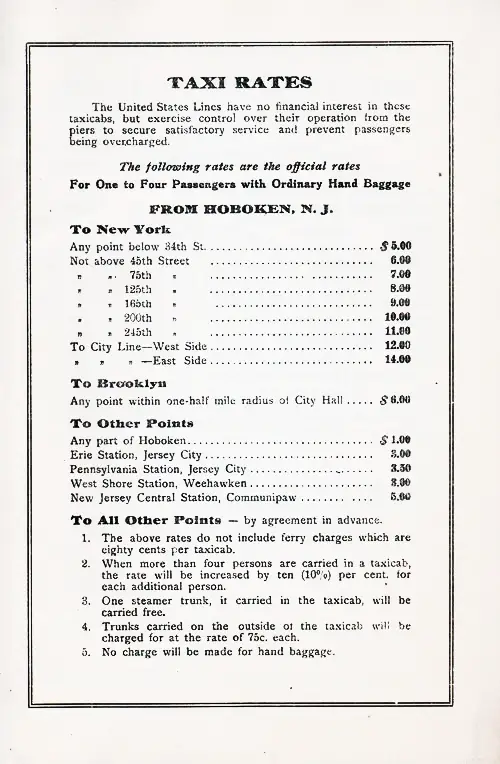
Taxi Rates from Hoboken to New York, Brooklyn, and Other Points, 1924. SS George Washington Passenger List, 22 August 1924. | GGA Image ID # 1e86d940a2
Return to Content Links
The George Washington, distinguished by war service and peace missions, now taken over by the U. S. Mail Steamship Company (United States Lines)
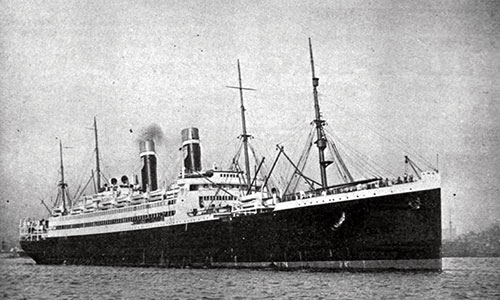
The Todd Shipyards Corporation Has Just Reconditioned the George Washington at the Expense of More Than a Million Dollars. | GGA Image ID # 1dadbf8676
AN IMPORTANT EVENT in the annals of the American Merchant Marine was signalized on August 3 when the big ex-German steamer George Washington sailed from New York on her first voyage under the flag of the United States Mail Steamship Company for Plymouth, Cherbourg and Bremen.
Built in the yards of the Stettin Vulcan at Bredow, the George Washington is the largest passenger liner ever to fly the American flag in peacetime service. She has been completely refitted by the Todd Shipyards Corporation at a cost of more than $1,000,000, a great accomplishment in itself, not only because every piece of equipment used in the reconstruction is of American origin but also because it shows we are capable of doing this class of work as well as if not better than foreign shipyards and certainly in much quicker time.
More than a hundred thousand soldiers were transported by the George Washington during the war, while she was used by President Wilson and his suite for both voyages to the Peace Conference at Versailles, by the King and Queen of Belgium upon their visit to the United States and by many other notable travelers. In view of these facts it has become one of the most famous vessels afloat.
Safety has been given even greater consideration than luxuries in the equipment and outfit of the vessel. Every Invention for adding to this vital element has been studied and, where practical, installed on the vessel. Among these inventions the radio compass, which was developed during the war for detecting the direction of the origin of radio signals has been adopted in order that the bearing of such signals sent from shore stations may be definitely determined and the position of the vessel itself located.
The Latest Equipment
The George Washington is equipped with one of the latest type gyro compasses. This equipment comprises the master compass and three repeated compasses, one of which is located in each wing of the bridge and one at the wheel for steering. The repeaters on the bridge are mounted in pelorus stands and take the place of the old dummy pelorus.
The cards in these repeaters are kept adjusted from the master compass to the true north at all times, so that accurate and true bearings can be taken at any time regardless of the ship’s head. The vessel is also equipped with a recording compass, which makes a permanent record of all the movements of the ship's head and makes possible the checking up of any changes of course which is desirable to record.
The usual items of equipment, such as radio, watertight subdivision, boat equipment, etc., have been perfected in the highest degree and the radio plant, consisting of the most powerful are light installation afloat is able to communicate with either shore from any position in the Atlantic while its maximum range under favorable conditions is approximately 7,000 miles. Watertight doors throughout the vessel are operated by hydraulic distant control from the navigating bridge and may be instantaneously closed as a whole or individually, as may be necessary in cases of emergency.
Latest in Fire Alarm Systems
The George Washington is equipped with one of the most complete and modern fire alarm systems available today. Fine copper tubing on the ceilings of these rooms are the detecting elements of this system. Their operation is unique in that it is not necessary for the heat from a fire to reach a high temperature before operating the system.
All that is needed is that there be a sudden rise in temperature in the room and the air confined in this fine copper tubing will expand, actuating the diaphragms. This principle makes the system extremely sensitive and no fire, no matter how remote or small, can gain any headway without the alarm being sounded in the engine room and on the bridge. The system is absolutely automatic and ready for service at any hour of the day or night.
The holds of the vessel are equipped with the latest improved type of the Rich Smoke System. This device is an extension of the steam smothering system required by law, which consists of a series of pipes leading from the boilers to all enclosed compartments and holds of the ship. This fire detecting system, by means of a small exhauster, draws air samples continuously from every compartment and hold and thus conveys the first traces of smoke to a detecting cabinet in the wheelhouse.
The smoke is revealed in the flares of the detecting cabinet immediately and definitely locates the fire during its incipient stage. By operating the proper valve, steam, or carbon dioxide if desired, can be directed to the specific location of the fire and through the same piping. With the closing off of the steam valve the indicating line is again re-established and detection continues unharmed by the action of the previous fire.
Interior Workmanship
The general arrangement of the interior has been allowed to remain somewhat in accordance with the original layout designed by the Germans but the details of the decorative features throughout have been refined and modernized in conformity with the best American practice.
The quality of the work of the specially trained joiners, cabinet workers and decorators of the Todd Shipyards Corporation proves that it is not necessary for us to go abroad to secure the most elaborate cabinet and inlay work. The very choicest of woods have been obtained from all parts of the world and there is scarcely a material used in the decorative art, which does not in some place find its use in the scheme of the design. There are to be found the various classes of mahoganies, teak, satin wood, ebony, maple, walnut, etc., which are in their respective places set off by inlays of other woods and mother of pearl and metallic decorations enhancing the effect of the whole.
Carpets and rugs of domestic manufacture and oriental weaves have been brought together from the choicest markets of the country in order to complete the floor coverings in all public spaces and private rooms. The decks and all passageways and public spaces have been covered with composition tilings of the highest quality.
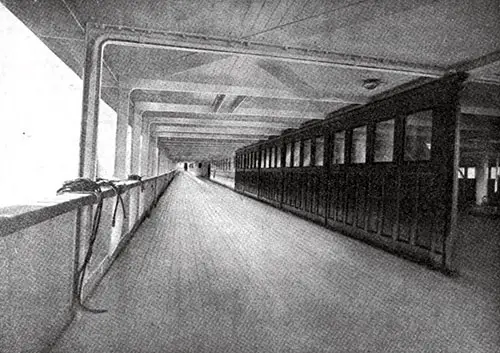
The Long and Wide Promenade Deck on the George Washington Makes a Delightful Stroll Possible on the Sea. | GGA Image ID # 1daddc787f
The general scheme of decoration varies with different sections of the vessel, but in general may be designated as that of a Continental character with variations and adaptations of the Colonial and Georgian periods which are drawn together to form a harmonious whole. Many of the paintings on the vessel are of American Colonial historical interest and represent scenes connected with the early days of our Republic, such as the Centennial Hall in Philadelphia, the home of Washington at Mount Vernon, various scenes of the National Capital and views of early New York and Boston.
Bronze and marble figures and busts adorn various niches throughout and include the men and women of Colonial fame, such as Washington, Martha Washington, Franklin and others.
Public Rooms
The lobbies about the passenger elevators leading to the grand social hall are tastefully finished in rectangular panels outlined with delicately tinted moldings and appropriately decorated. The elevator enclosures consist of hand-wrought iron screens and the floors of the lobby within the limits of the vestibules are well tiled and laid with heavy rugs.
Telephone System
Cabin staterooms and suites are interconnected by a telephone system of the most modern approved American design and practice and the passenger may communicate throughout with the various officers, stewards, etc., without leaving his own room. The wireless telephone has also been installed and it is possible to stand upon the vessel and communicate by word of mouth with other similarly equipped vessels or shore stations at a distance of approximately 500 miles.
The installation is fitted with amplifiers in order that speeches, music or other sounds may be received at their origin in a lecture hall or theatre and heard by all gathered in a dining room or other public space on the vessel.
Other Public Rooms
Aft on the boat deck are the enclosed veranda-cafe, the first class upper smoking room, the radiotelephone and telegraph office, the photographic dark room, newspaper office and similar spaces of general public interest.
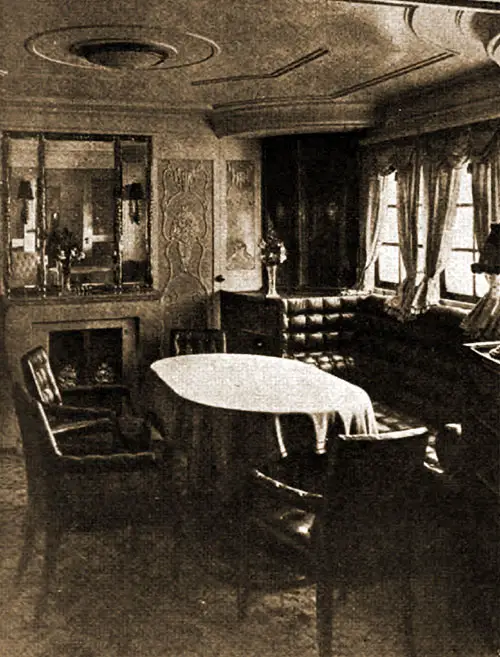
The Dining Room of the Presidential Suite Has Been Used Not Only by Former President Wilson but by King Albert of Belgium and Other Notable Travelers. | GGA Image ID # 1dae253333
The upper promenade or A deck is glass enclosed throughout and assures open spaces for exercise and recreation independently of weather conditions. An unusually spacious and beautifully decorated reading and writing room is situated on the A deck well forward, and offers an unobstructed view abead and to port and starboard. In addition to its permanent loan collection of the finest literature, it contains a magazine and book store and the offices of the public stenographer.
The reading and writing room is finished In natural satin-wood, inlaid with ebony and mother of pearl, developed along the lines of the Continental style. The cabinetwork about the room consists of writing desks, bookcases, cabinets, settees, etc., executed with extreme skill and certain doors are decorated with elaborate hand-wrought wood and metal grilles and screens to harmonize with the whole. The portable furniture and tables are constructed and upholstered to correspond.
The grand social hall, which is the largest individual public room on the vessel, is located on the A deck right aft of the reading room and consists of a main central hall and four ante-rooms or bays. The center of the floor is a large hardwood dancing area which, when not being used, is covered by heavy rugs. This room is finished in shades of felted French gray and decorated with a series of paintings of Colonial American interest including a well-known portrait of George Washington which is mounted over a Colonial fireplace of exceptionally artistic design.
The skylight, which covers the entire central area of the room, is of heavy leaded glass in simple and appropriate artistic design illuminated by numerous electric lights providing for an indirect system of illumination. The fireplace and mantel at the head of the room are exceptionally complete and correct examples of the Georgian period. A grand piano, settees, party and individual tables, social and winged aim chairs upholstered in tapestry and brocades are placed about the room and form a convenient and attractive setting.
Each of the four ante-rooms, which are separated from the main area of the hall by panel work and heavy brocade hangings, is developed in an individual style in natural mahogany, walnut, etc., and the walls finished with silk panels matching the natural woodwork. Suitable tables, settees and chairs are furnished and the spaces form charming nooks for card parties, luncheon or tea service as may be desired.
At the aft end of the grand social hall is a monumental stairway which is finished in felted grays to match the colors of the room and which leads directly to the foyers of the deluxe suites on the deck below. It is ornamented in a simple style of panel work and mirrors and a clock on the electric time system of the vessel.
The lower smoking room which terminates the first class passenger accommodations on A deck is furnished in natural walnut inlayed with ebony. The walls of this room are decorated in embossed, hand-worked leather of rich brown tones and panes of plate glass mirror enclosed in metal frames surmount a marble mantel above an electric fireplace at the after end of the room.
Heavily upholstered, fixed settees and arm chairs finished in blue leather, together with individual and party tables are placed about the room for the comfort and convenience of its occupants. A counter for the sale of cigars, cigarettes, etc. is located at the forward starboard corner of the room.
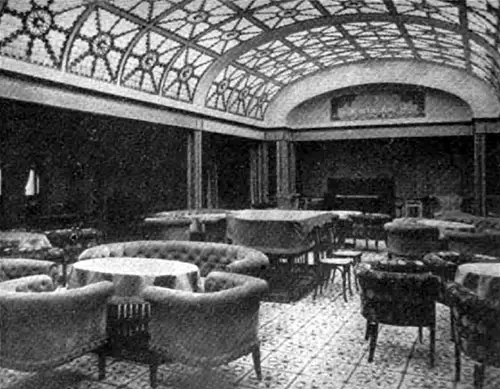
A Social Hall Replete with Facilities for the Entertainment of Passengers Graces the George Washington. | GGA Image ID # 1dae4ea809
The B deck is given over chiefly to first class accommodations consisting of rooms with individual baths and deluxe suites. There are four deluxe suites of particular elaborateness, President, Mrs. Wilson occupied two and the King, and Queen occupied one of Belgium during their respective voyages upon this vessel.
These suites are located on B deck at the foot of the monumental stairway from the grand social hall and each consists of a living room, dining room, bed room and bath. These suites are marked with silver plates giving the names of their former distinguished tenants with brief reference to their voyages and will be a natural center of attraction to all travelers on board the vessel. The suite on the port side, used by President Wilson and the King and Queen of Belgium when on the vessel, is constructed in veneers of mahogany and rosewood, inlaid with satin and other lighter woods and decorated with panels of raised plastic. Mahogany and rosewood have been used freely in the furniture and every effort has been made to hold the room intact, as used by the President, for its deep historical interest.
A replica of the desk upon which the President prepared his first drafts of the Peace Treaty stands in the Presidential suite in the exact position occupied by the original, which has been presented to the President by the Directors of the Company. The beds, dressing table, toilet receptacles, portable furniture, etc., are in woods matching with the panel work of the room and exhibit some of the finest cabinet making that can be produced in the United States.
The foyers and open spaces of the B deck are decorated in a Continental style.
The interior of the rooms and suites forward of the main monumental stairway are finished in the choicest of hardwoods with the most elaborate and painstaking cabinet inlay work that can be obtained. The curtains, upholstery, hangings, etc., are of corresponding style and finish and the portable furniture in the rooms designed and manufactured for their specific locations. Bath and toilet rooms are fitted with the most modern, complete plumbing, and finished generally in enamel tile. The decks of each of the suites and rooms on B deck are heavily carpeted and laid with oriental rugs of the choicest weaves.
There are also upon B deck the electric baths with their adjacent massage rooms, showers and dressing rooms for the use of the passengers. At the after-end of the first class quarters on this deck is also found the gymnasium, which is properly and simply furnished in maple and equipped with the usual athletic apparatus, ladies’ and gentlemen’s dressing rooms and bathrooms.
The bedrooms and sitting rooms on the lower decks are constructed generally in a manner equal to that on the upper decks but with a less elaborate scheme of decoration and finish. The general character of these rooms throughout the vessel, however, is one of quality and refinement, wherein workmanship and materials have been used with utmost discrimination to produce appropriate results.
The main dining saloon, with a seating capacity of approximately 350, is located in the center of the vessel upon the lower first class passenger deck or D deck. The saloon is exceptionally commodious and is surmounted by a center dome reaching to the second deck above. The room is designed and constructed In the Colonial and Georgian style and finished in cool shades of French gray.
The decorations of the dome consist of Doric and Ionian columns with a well-designed wrought iron rail on the level of the upper deck which presents a most satisfying appearance of grace and lightness. Buffets and service tables are situated at convenient points and large mirrors fitted in the fore and after wall panels add to the spaciousness of the entire room.
The upholstery and hangings of the room are in old rose and all sidelights are fitted with inner sashes and draped with silk curtains in corresponding shades. The choicest of linen, silver, china and glass have been obtained and when the room Is set an appearance of charm and refinement results which satisfies the most fastidious of tastes.
Children's Playroom
The children's dining and playroom, which is adjacent to the main dining room has been laid out as one of the most delightful spaces on board the vessel. It is finished in French gray and old rose upholstery and decorated with gaily colored prints of suitable character to appeal to this highly prized group of passengers.
Second Class Accommodations
There are accommodations for 442 second class passengers in spacious state rooms with dining rooms, smoking rooms, sitting and writing rooms, etc., in a proportionate degree of elaborateness and with ample deck space for promenade and games. The arrangement of these spaces is such that there can be no feeling of discrimination upon the part of the passengers traveling in these quarters.
Foyers and public rooms of the second class accommodations have also been carefully and appropriately worked out by the decorating architect and while In more simple lines and details than the first class still exhibit the workmanship of a true artist and fully satisfy the most exacting.
Third Class Accommodations
Third class passengers to the number of 1,485 are accommodated in rooms containing two, four and six berths or in open compartments as the individual traveler may select. As in the case of the other classes, these accommodations are made up in part of dining rooms, smoking rooms, writing rooms, etc., so that travelers in this class, while having less space and comparatively limited luxuries, may find perfect comfort and cleanliness with unlimited light, air, heat and all the necessities of ocean travel.
Shipping Magazine: Marine Transportation, Construction, Equipment and Supplies, Volume 14, No. 3, August 10, 1921, P. 18-21
Return to Content Links

